
1
Psychology
Part-
1
/
For 4
th
stage
Prof. Elham Aljammas

2
Index
1- Introduction
2- Thinking
3- Memory
4- Personality Development
5- Intelligence
6-Motivation
7-Emotion
8-Stress&coping
9-Learning
10- Biological basis of behavior ɪ
11- Biological basis of behavior ɪɪ
12-Sleep&Dream
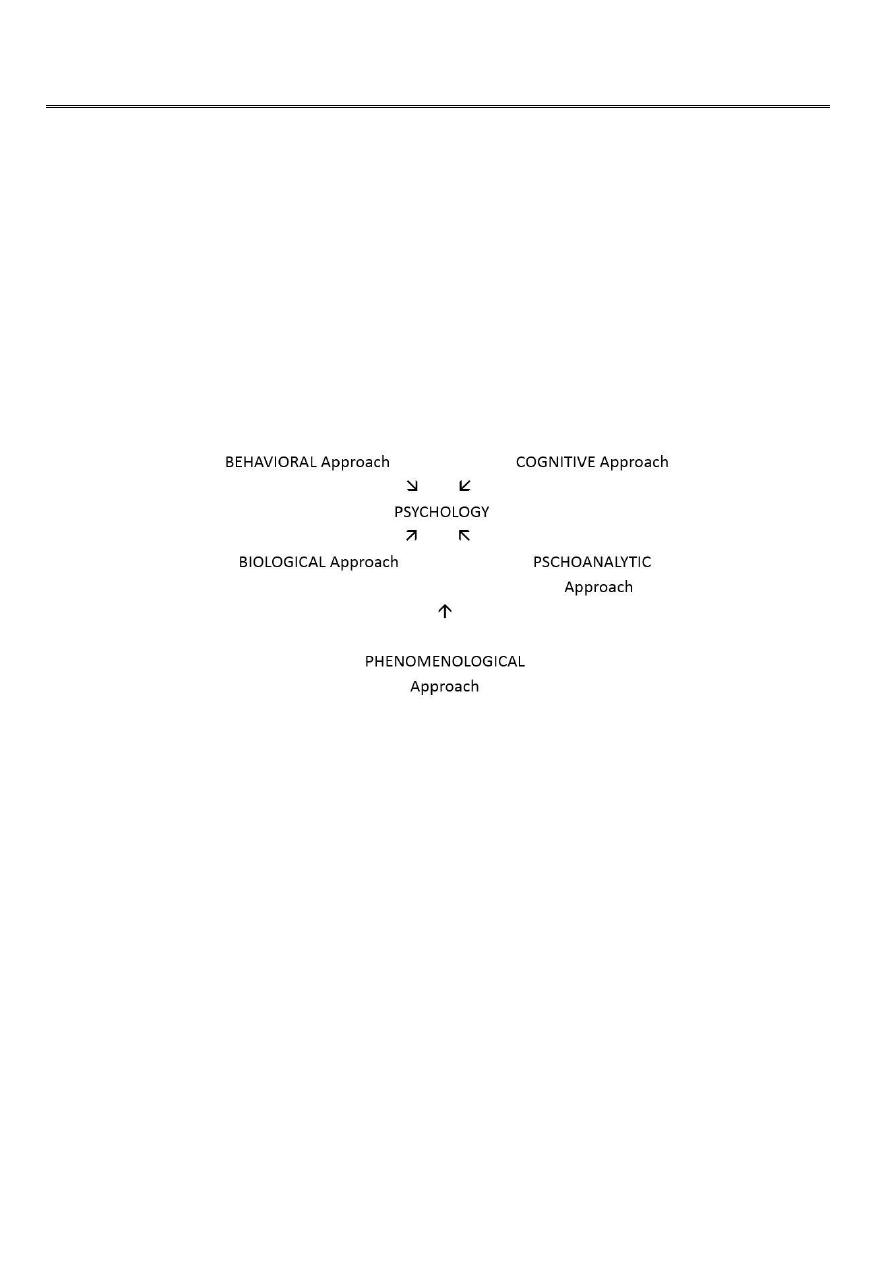
3
4th stage
Introduction
Lec-1
ا.د.الهام
الجماس
4/10/2015
Objectives
1. To understand the meaning of psychology & its correlation to different factors.
2. To differentiate between normality & Abnormality
3. To determine the criteria that differentiate normality from abnormality
Definition:
Psychology is defined as the scientific study of behavior & mental processes.
Parts:
The nature of psychology
Psychological development
Sensory processes
Perception
Consciousness
Learning and conditioning
Emotion

4
Criteria to distinguish normal & abnormality behavior:
Definitions:
1. Statistical Definition Abnormal=away from normal (e.g.) Height, Weight & intelligence
2. Social Definition Abnormal = Deviation from social norms or acceptable behavior.
3. Maladaptiveness of behavior: How the behavior affect the wellbeing of the individual
or of the social group (e.g.) alcoholic, violence …etc.
4. Personal Distress Individual subjective feelings of distress rather than the individual's
behavior (e.g.) mental illness.
Normality:
Difficult to define.
The following qualities indicate emotional wellbeing.
1. Efficient perception of realty.
2. An ability to exercise voluntary control over behavior.
3. Self-esteem & acceptance (i.e.) appreciate their own self-worth & feel accepted by those
around them.
4. An ability to form affectionate relationship (i.e.) form a close & satisfying relationship
with people.
5. Productivity. Lack or excess
Classifying abnormal behavior:
1. DSM1V diagnostic statistical manual
2. ICD10 international classification of diseases (mental) no.10
Important: all
Important: short assay
Note:
Psychology normal (physiology)
Psychiatric abnormal (pathology)
Important: all
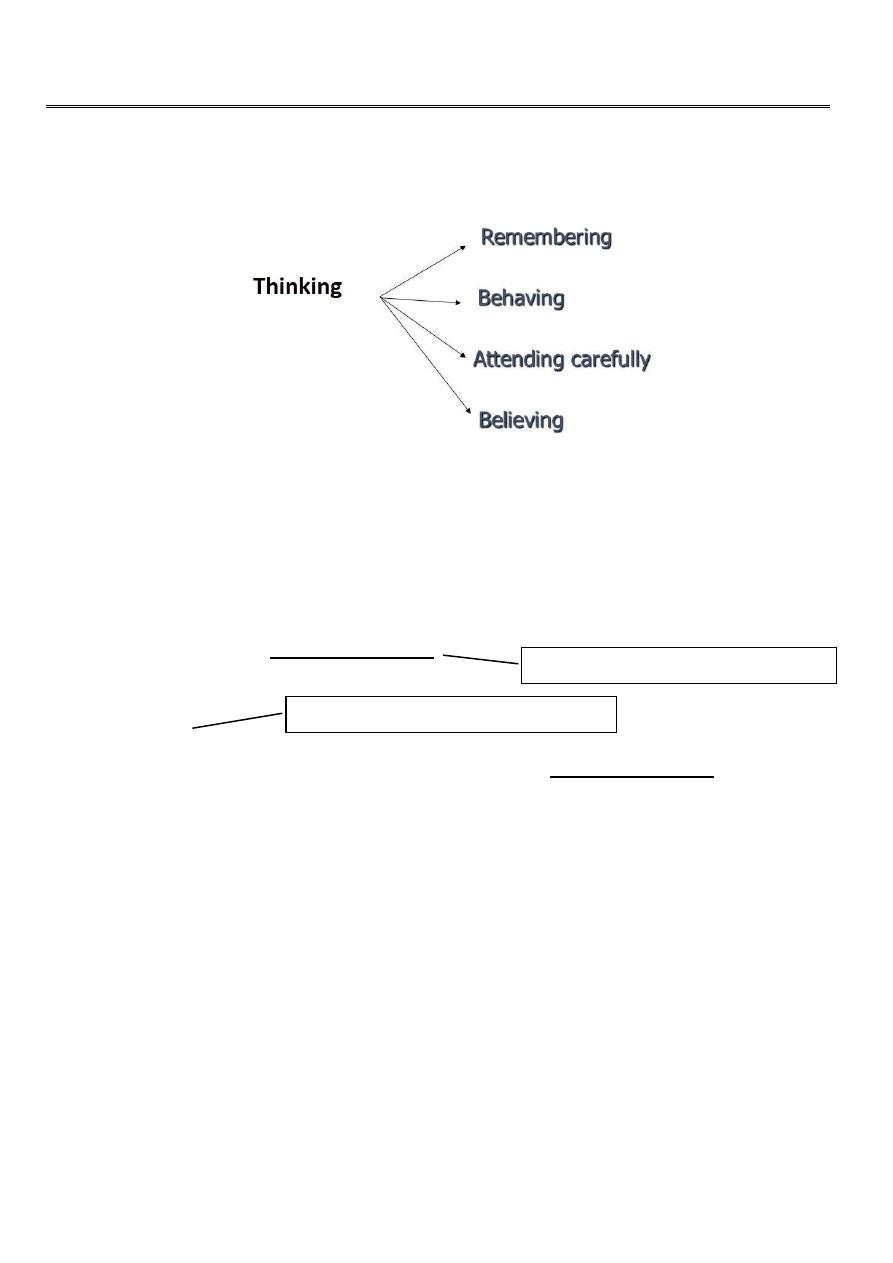
5
4th stage
Thinking
Lec-2
ا.د.الهام
الجماس
4/10/2015
Thinking represent many most complex form of behavior, the highest of mental activity
The important of thinking is the use of symbol theses symbol may be a word, images,
movement, mathematical symbol or others.
The use of language i.e. verbal symbols.
Mans ability to use symbol is only characteristic of his thinking, he organize the information
into pattern this is called Concept formation.
-
Generalization.
-
Abstract.
The whole process of generalization and abstract is called Concept formation and this is the
mechanic of thinking.
Problem solving behavior:
We use thinking in problem solving behavior the classical is reported by Dunker ex.
The Effect of previous Experience
:
The extend to which previous experience could affect thinking done by many reserches,
one of these done by Main, he set groups of subject, the 1
st
group had no previous
experience he gave them an apparatus to construct from many component find difficulty to
solve the problem while the 2
nd
group who had previous experience find no any difficulty to
construct the apparatus.
Important: definition of abstract
Important: definition of concept
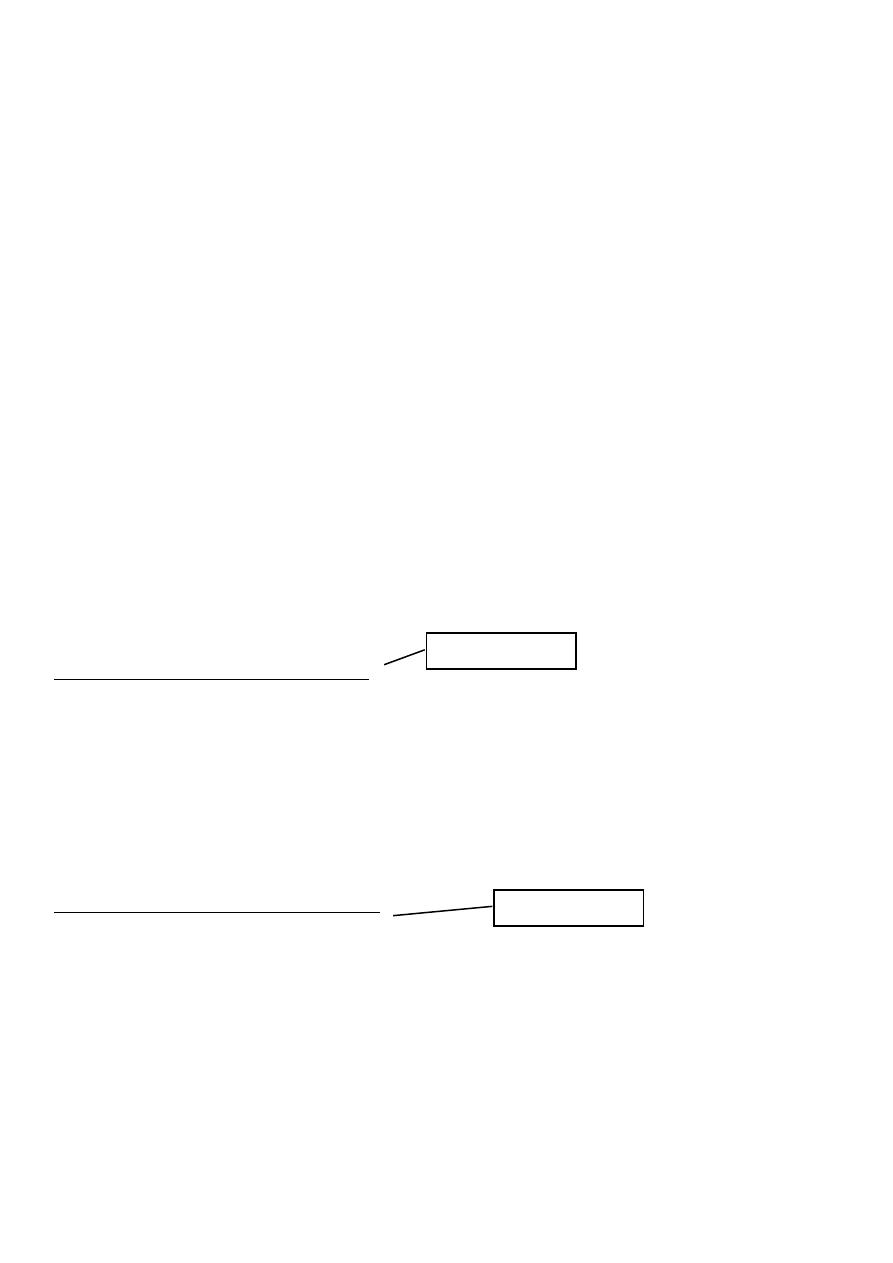
6
Bodily process in thinking:
We are completely inactive physically is thinking out problem, but it has shown certain
bodily processes accompany thinking, there is muscular movement are involved in mental
process
During thinking certain recordable nervous and muscular changes occur even although they
are not apparent either to the thinker or to the observer and this can be recorded by EMG
and EEG.
Autistic thinking: it is a fantasy thinking, this may be adjustment to intorable situation
excessive fantasy thinking occur in schizophrenia and in normal people.
Primary and Secondary process in thinking:
-Primary process are these which dominate in infancy and children ch. By immature,
primitive tendency to immediate gratification of basic instinctual drive or needs.
- Secondary process are more mature and directed way of thinking, here the instinctual
impulses can be controlled or delayed or substituted by another form of gratification.
Thought Disorder
1. Disorder of the stream of thought:
o Inhibition of thought. {Depression}
o Pressure of thought. {mania or schizophrenia}
o Flight of Ideas. {mania}
o Thought Blocking. {schizophrenia}
o Incoherence of Thought {schizophrenia}
o Circumstantial pressure of talk. {mania or schizophrenia}
o Preservation- speech disorder. {dementia}
2. Disorder of the Content of Thought:
o Delusion – A fixed false unchable belief is out of keeping with person educational and
cultural background, not shared by others.
o An over – valued idea- an idea that because of its feeding tone takes precedence
overall other ideas, it may be true or false.
Important: all
Important: all
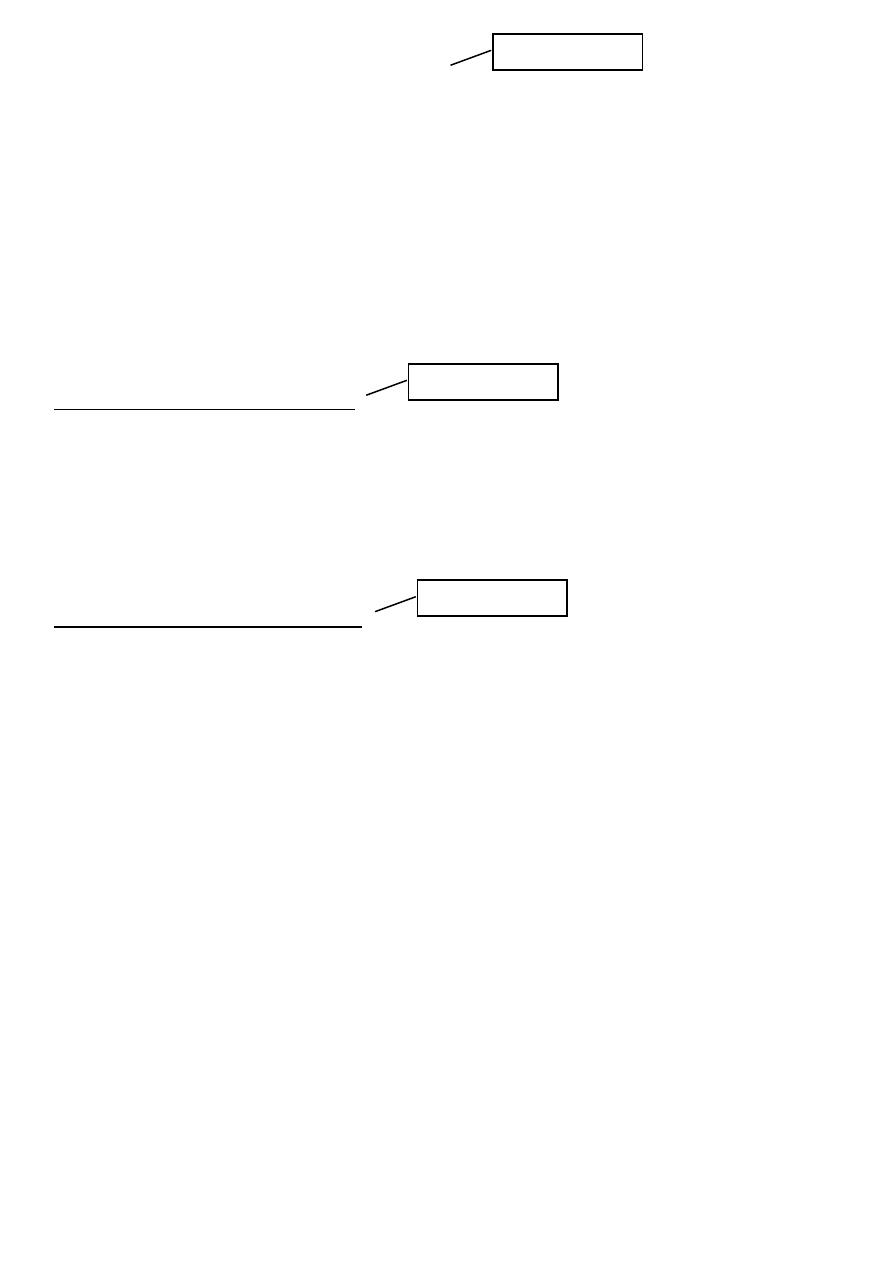
7
Types of delusion according to content
1. Paranoid Delusion.
2. Hypochondriacal delusion.
3. Delusion of guilt
4. Delusion of poverty
5. Nihlistic delusion
6. Grandiose delusion.
7. Persecutory delusion.
8. Ideas of self-reference.
9. Primary and secondary delusion.
3. Disorder of the form of thought:
o Negative formal thought.
o Positive formal thought Disorder (No abstract thinking).
o Neologisms.
o Self –reference of thinking.
o Talking past the point ( here the pt. gives a worong answer
4. Disorder of possession of thought
o Here the individual is compelled to think his own thought against his will.
1. Obsessional thought cun be classified into:-
a. Obsessional ideas or mental images.
b. Obsessional impulses.
c. Obsessional phobias.
d. Obsessional Ruminations.
Obsessions may occur in obsessional neurosis, in depression, in schizophrenias, and
organic states.
2. Alienation of thought –this takes three forms:-
a. Thought withdrawal
b. Though insertion.
c. Thought broadcasting
Important: all
Important: all
Important: all
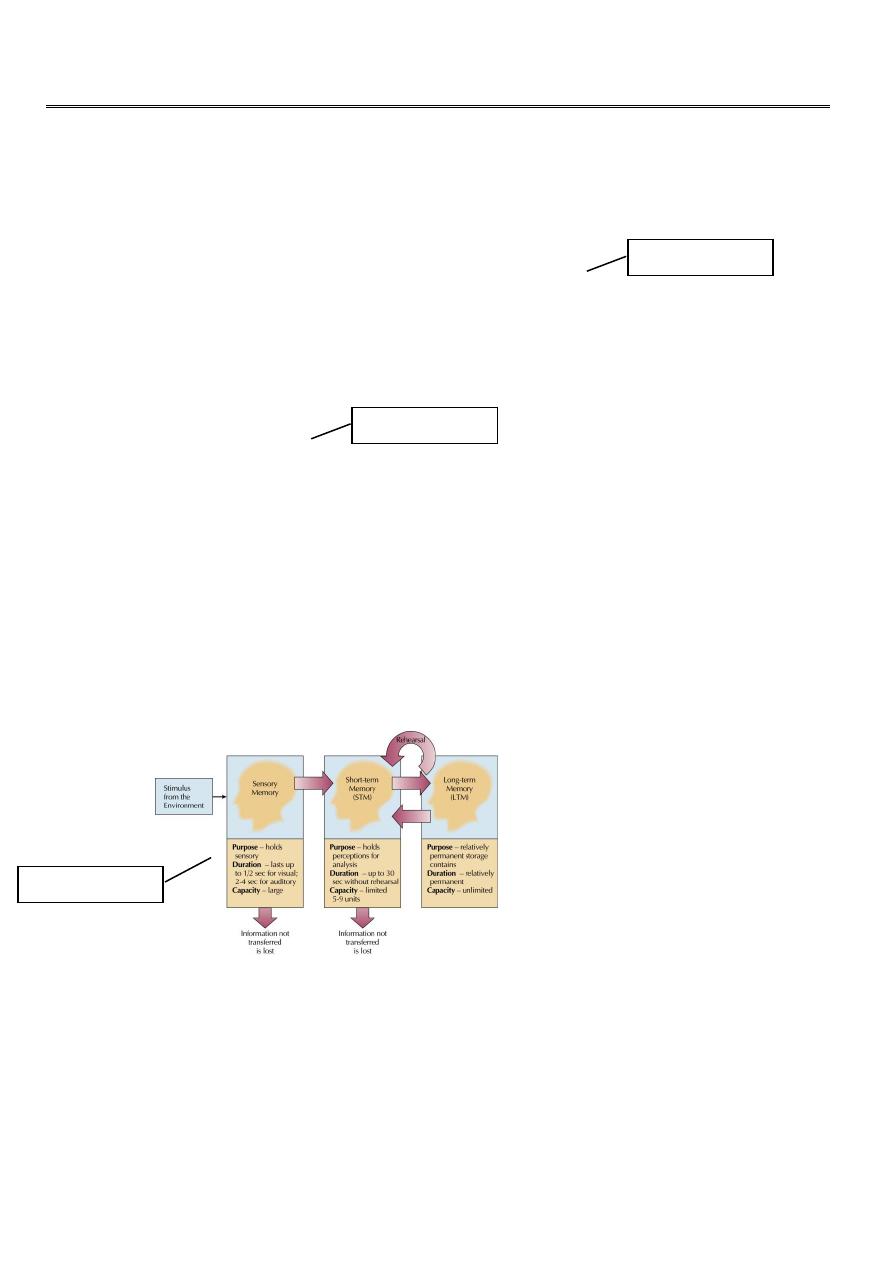
8
4th stage
Memory
Lec-3
ا.د.الهام
الجماس
4/10/2015
Three-Stage Model of Memory
Forgetting and Memory
Problems with Memory
Memory Improvement
Memory is the ability to code, store and retrieve information
Memory involves coding the input of the senses (visual, auditory)
Memory is rarely perfect
Forgetting refers to memory failure
Three Stages of Memory:
Sensory Memory is a brief representation of a stimulus while being processed in the
sensory system
Short-Term Memory (STM) is working memory
o Limited capacity (7 items)
o Duration is about 30 seconds
Long-Term Memory (LTM) is large capacity and long duration
Overview of Memory Model:
Important: all
Important: all
Important: all
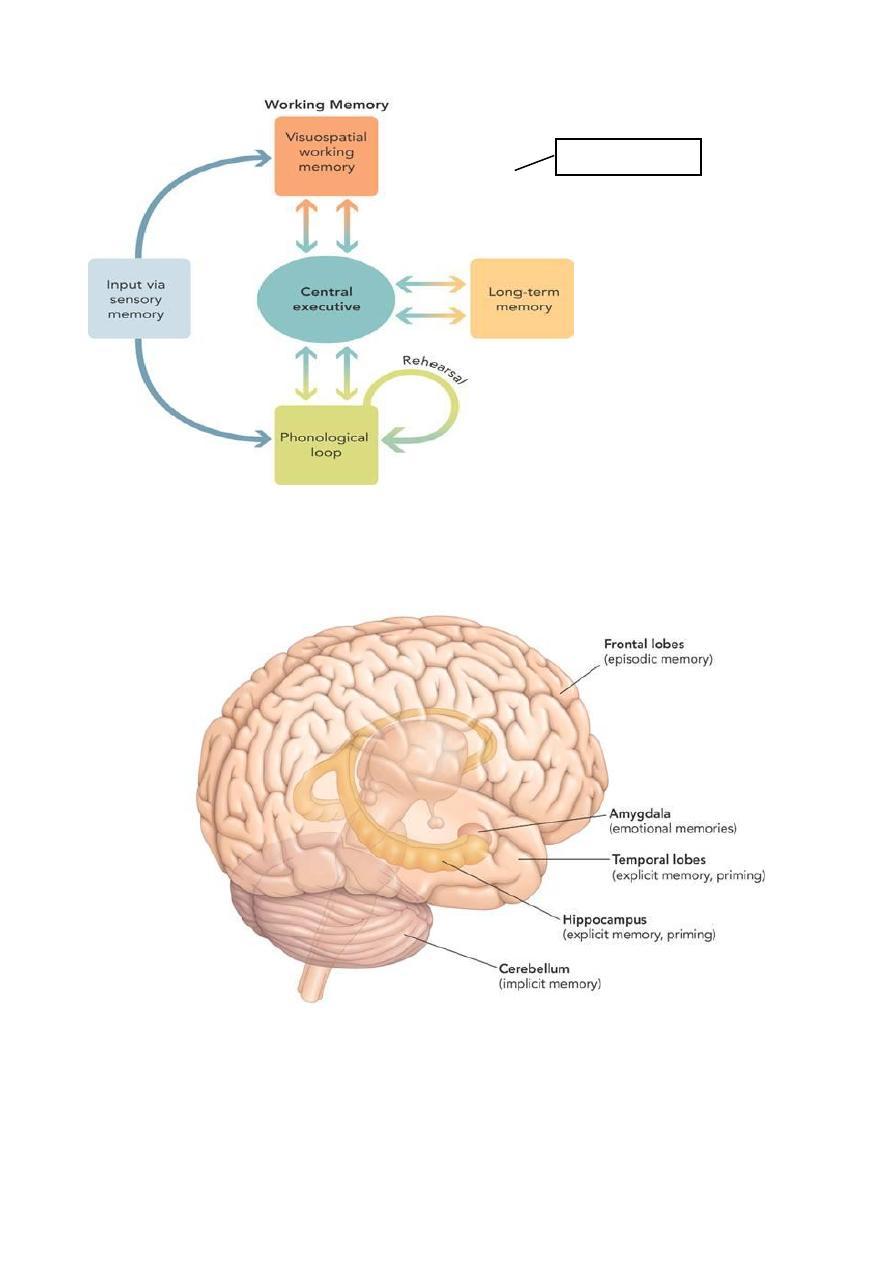
9
Working Memory Model:
Memory: Brain Structures
Important: all
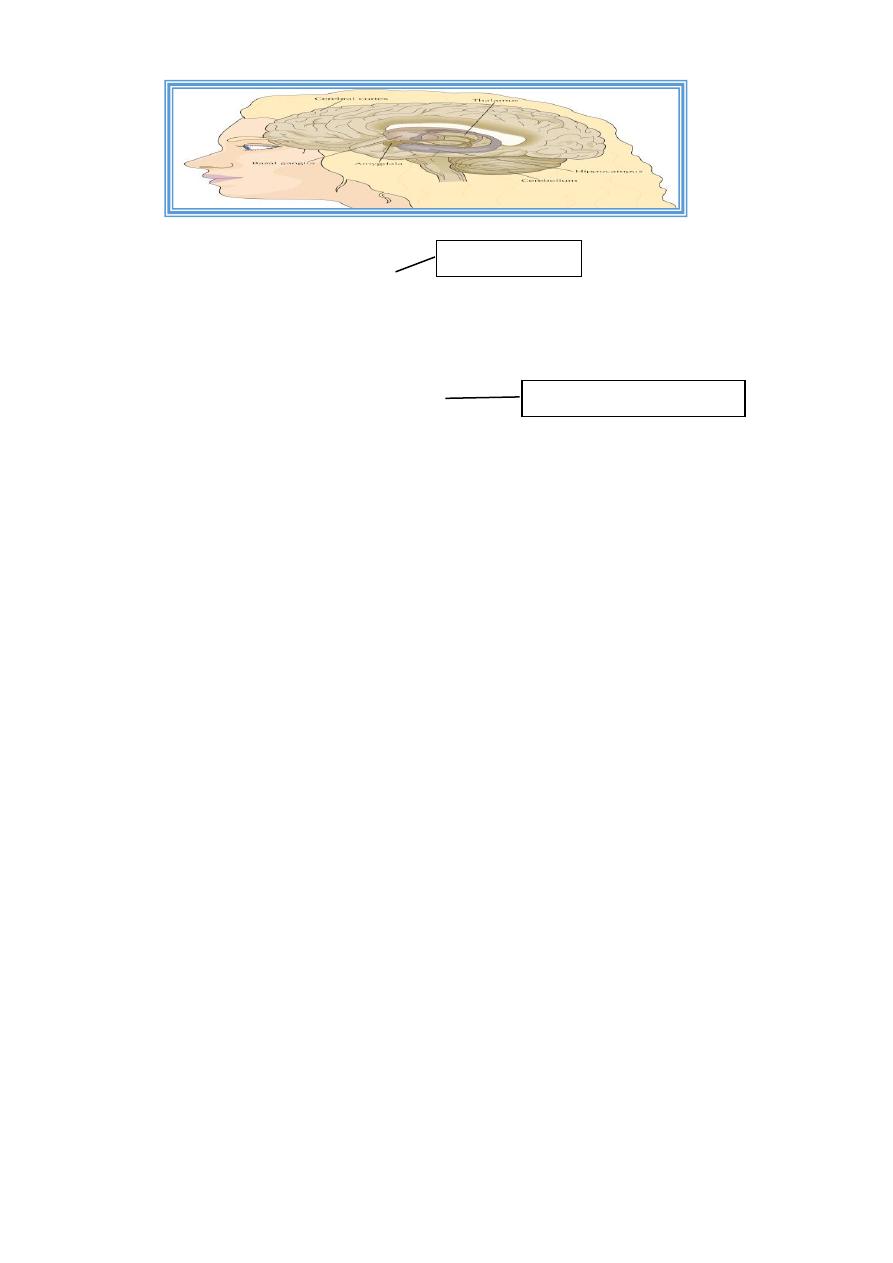
11
Where Are Memories Located?
Memory tends to be localized and distributed throughout the brain--not just the cortex.
Why Do We Forget? Five Key Theories
Decay
Interference
Motivated Forgetting
Encoding Failure
Retrieval Failure
Five Theories of Forgetting:
1. Decay Theory: memory degrades with time
2. Interference Theory: one memory competes (interferes) with another
– Retroactive Interference (new information interferes with old)
– Proactive Interference (old information interferes with new)
3. Motivated Forgetting: motivation to forget unpleasant, painful, threatening, or
embarrassing memories
4. Encoding Failure: information in STM is not encoded in LTM
5. Retrieval Failure: memories stored in LTM are momentarily inaccessible (tip-of-the-
tongue phenomenon)
Important: all
Important: enumerate
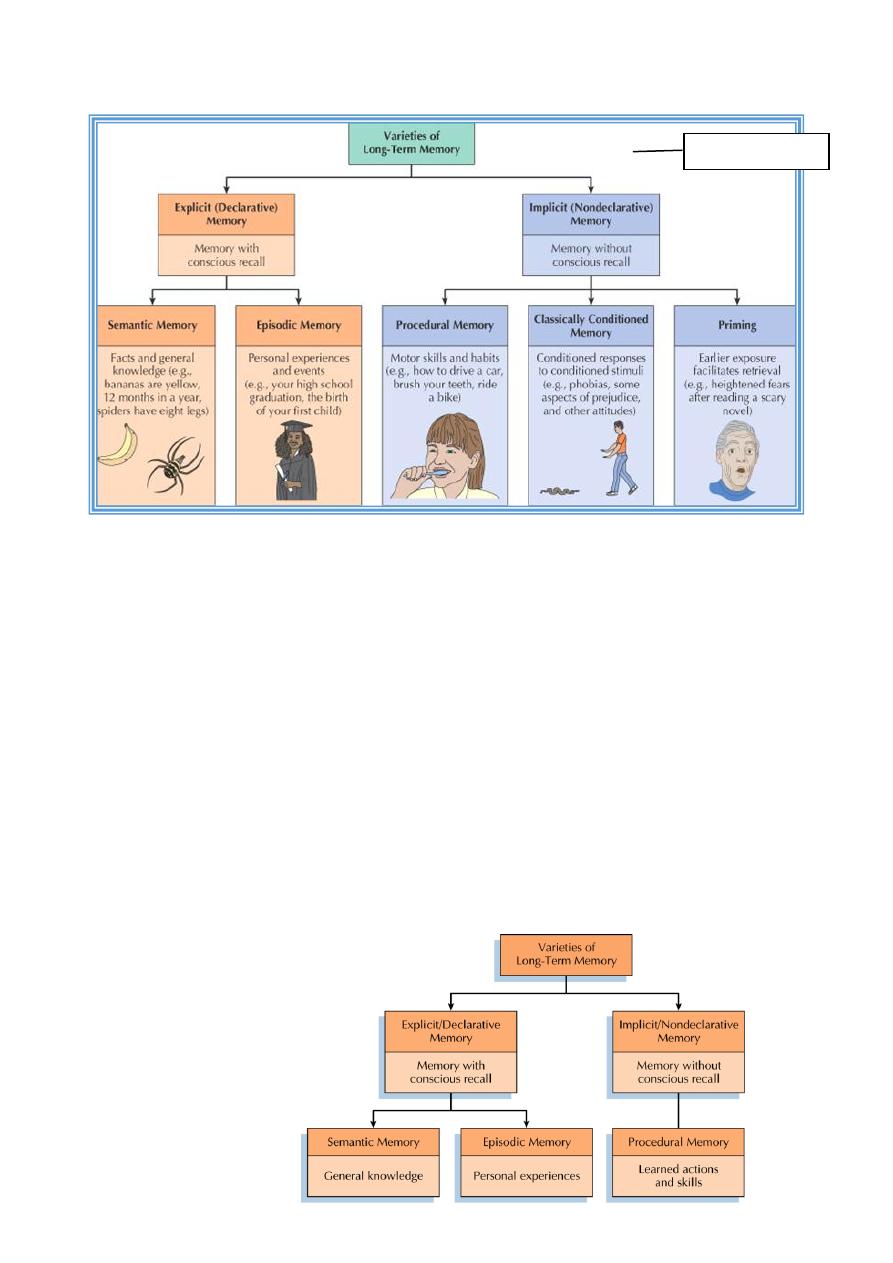
11
Types of Long-Term Memories:
Long-Term Memory:
Information transferred from STM to LTM is coded into categories and stored in terms of
meaning
REM sleep may play a key role in categorizing new items within LTM
Memories retrieved from LTM are not an exact replica of the original event
Memories are reconstructed and can be altered during the retrieval process
Varieties of LTM:
Psychologists distinguish between two types of LTM
Semantic memory refers to factual information (What is the capital of Georgia?)
Episodic memory refers to autobiographical information as to where and when an event
happened
“I remember visiting the capital of of Georgia”
Overview of LTM:
Important: all
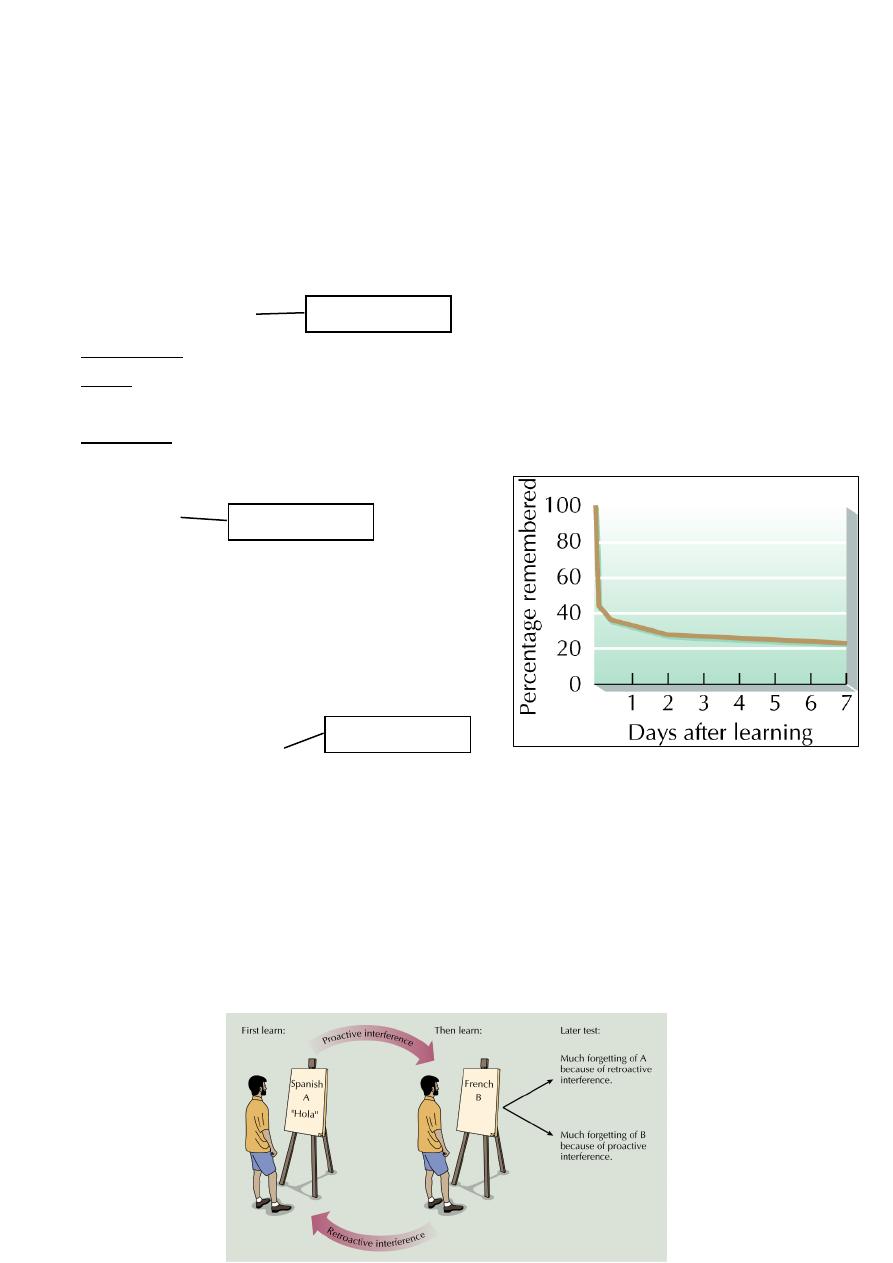
12
Organization of LTM:
Items in LTM are organized in categories that form a hierarchy with multiple paths (direct
and indirect) to each item
Sometimes the cues required to recall an item are not sufficient
Tip-of the tongue phenomenon: person can’t easily recall the item, but shows some
recall for its characteristics (“…it begins with the letter ….”)
Memory Measures:
Recognition is when a specific cue (face or name) is matched against LTM
Recall is when a general cue is used to search memory
E.g. define the term “statistical significance”
Relearning refers to a situation in which a person learns material a second time.
Memory is evident in savings of time to relearn
the second time versus the first
Forgetting:
Forgetting is the inability to recall previously
learned information
Forgetting rate is steep just after learning and
then becomes a gradual loss of recall
Theories of Forgetting:
Interference theory argues that information competes for retrieval
o Proactive interference: old information interferes with recall of new information
o Retroactive interference: new information interferes with recall of old information
Decay theory: memory trace fades with time
Motivated forgetting: involves the loss of painful memories (protective memory loss)
Retrieval failure: the information is still within LTM, but cannot be recalled because the
retrieval cue is absent
Interference
and Memory:
Important: all
Important: all
Important: all
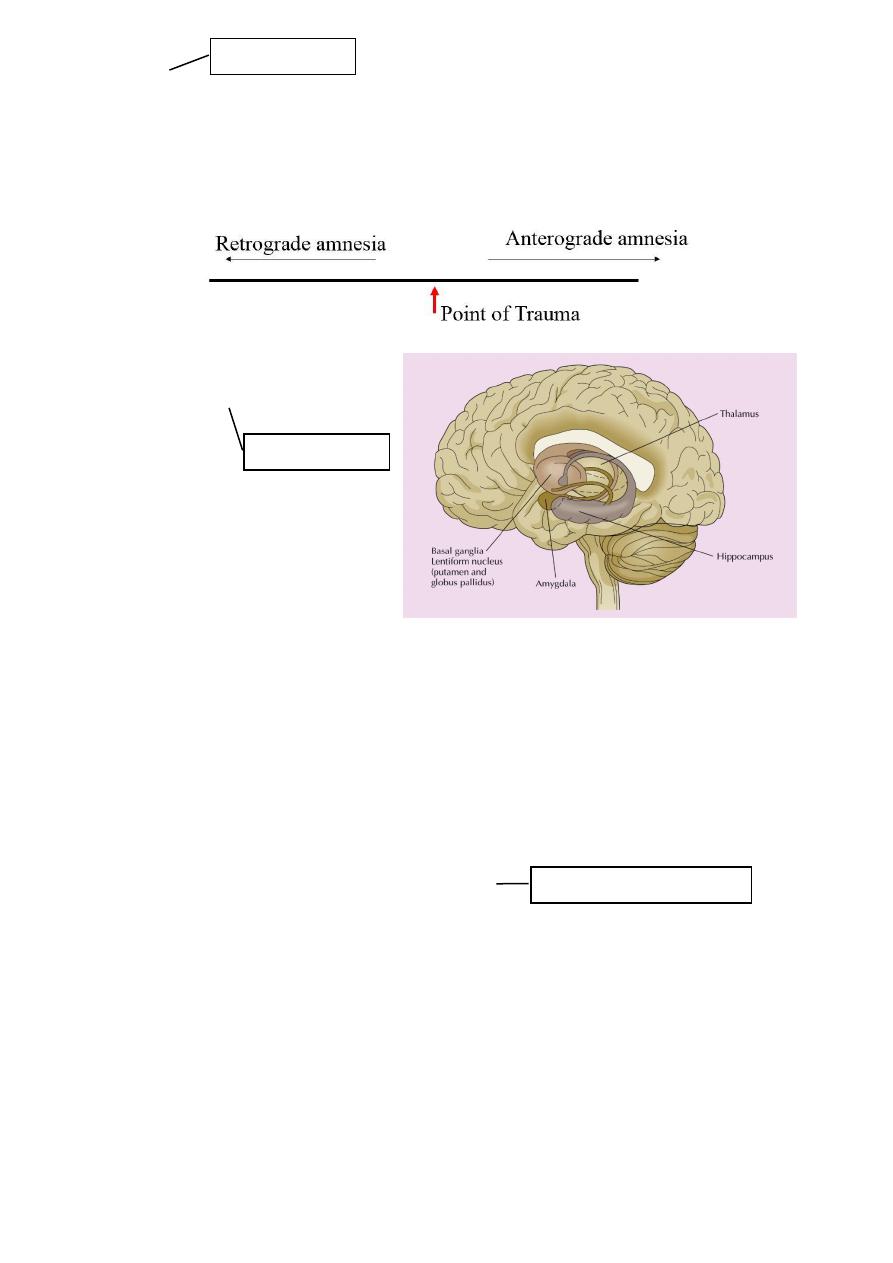
13
Amnesia:
Amnesia is forgetting produced by brain injury or by trauma
Retrograde amnesia refers to problems with recall of information prior to a trauma
Anterograde amnesia refers to problems with recall of information after a trauma
Anatomy of Memory:
Bilateral damage to
the hippocampus
results in anterograde
amnesia (Patient H.M.)
Issues in Memory:
Memory recall may involve reconstruction and thus may not be accurate
Reasons for inaccuracy of memory:
o Source amnesia: attribution of a memory to the wrong source (e.g. a dream is recalled
as an actual event)
o Sleeper effect: a piece of information from an unreliable source is initially discounted,
but is recalled after the source has been forgotten
o Misinformation effect: we incorporate outside information into our own memories
Using Psychology to Improve Our Memory:
Eight Tips for Memory Improvement:
1. Pay attention and reduce interference
2. Use rehearsal techniques
3. Organization
4. Counteract serial position effect
5. Time management
6. Use encoding specificity principle
7. Employ self-monitoring and overlearning
8. Use mnemonic devices (e.g., method of loci, peg-word, substitute word, word
associations)
Important: all
Important: all
Important: enumerate

14
Memory Strategies:
Mnemonic devices are strategies to improve memory by organizing information
o Method of Loci: ideas are associated with a place or part of a building
o Peg-Word system: peg words are associated with ideas (e.g. “one is a bun”)
o Word Associations: verbal associations are created for items to be learned
Other strategies for improving memory:
o Pay attention and avoid interference
o Use rehearsal techniques
o Improve the organization of your memory
o Manage your time
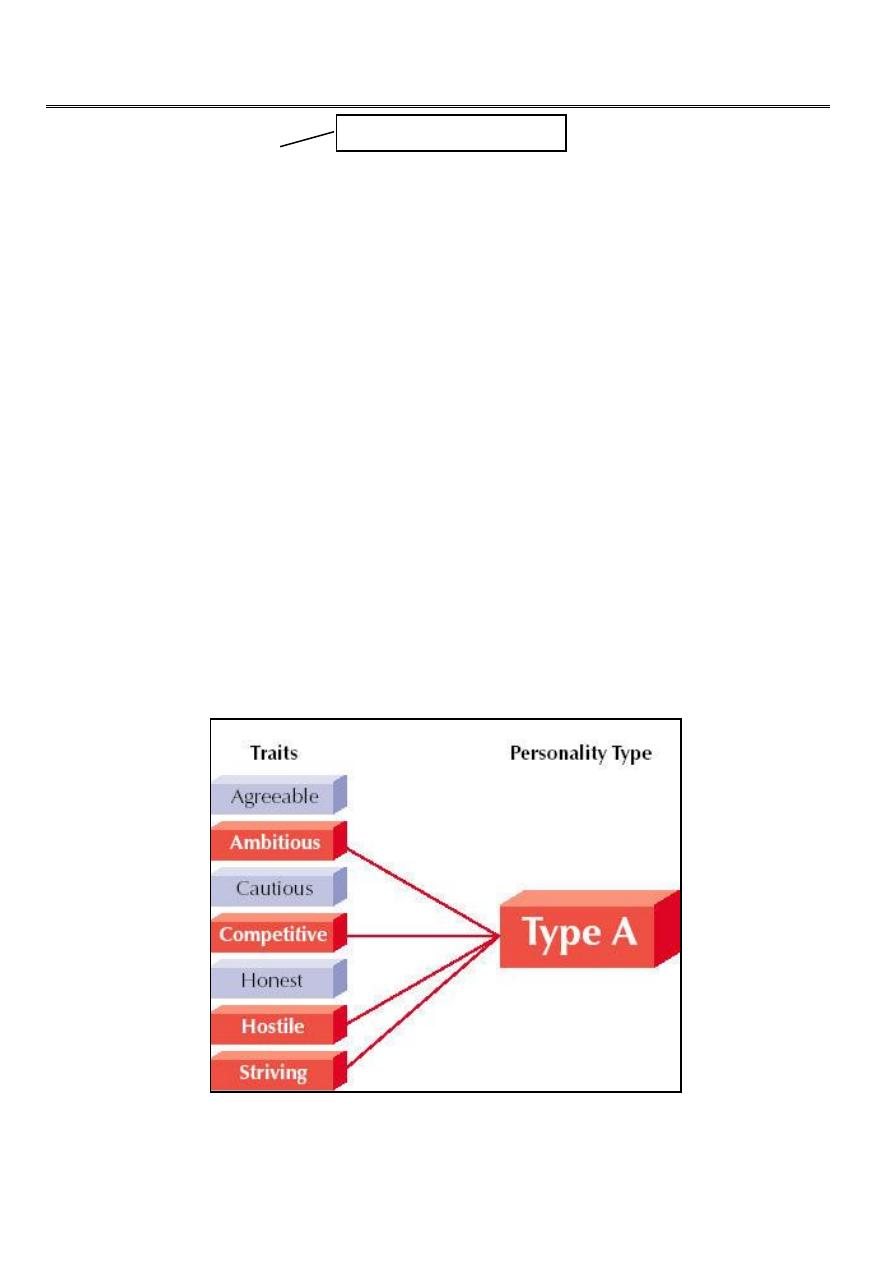
15
4th stage
Personality Development
Lec-4
ا.د.الهام
الجماس
5/10/2015
Topics to Explore:
1. Trait Theories
2. Psychoanalytic Theory
3. Social-Cognitive Theories
4. Humanistic Theories
Some Terms:
1. Personality: a person’s internally based characteristic way of acting and thinking
2. Character: Personal characteristics that have been judged or evaluated
3. Temperament: Hereditary aspects of personality, including sensitivity, moods,
irritability, and distractibility
4. Personality Trait: Stable qualities that a person shows in most situations
5. Personality Type: People who have several traits in common
Example of Personality Type:
Personality Theory:
System of concepts, assumptions, ideas, and principles proposed to explain personality.
Important: enumerate
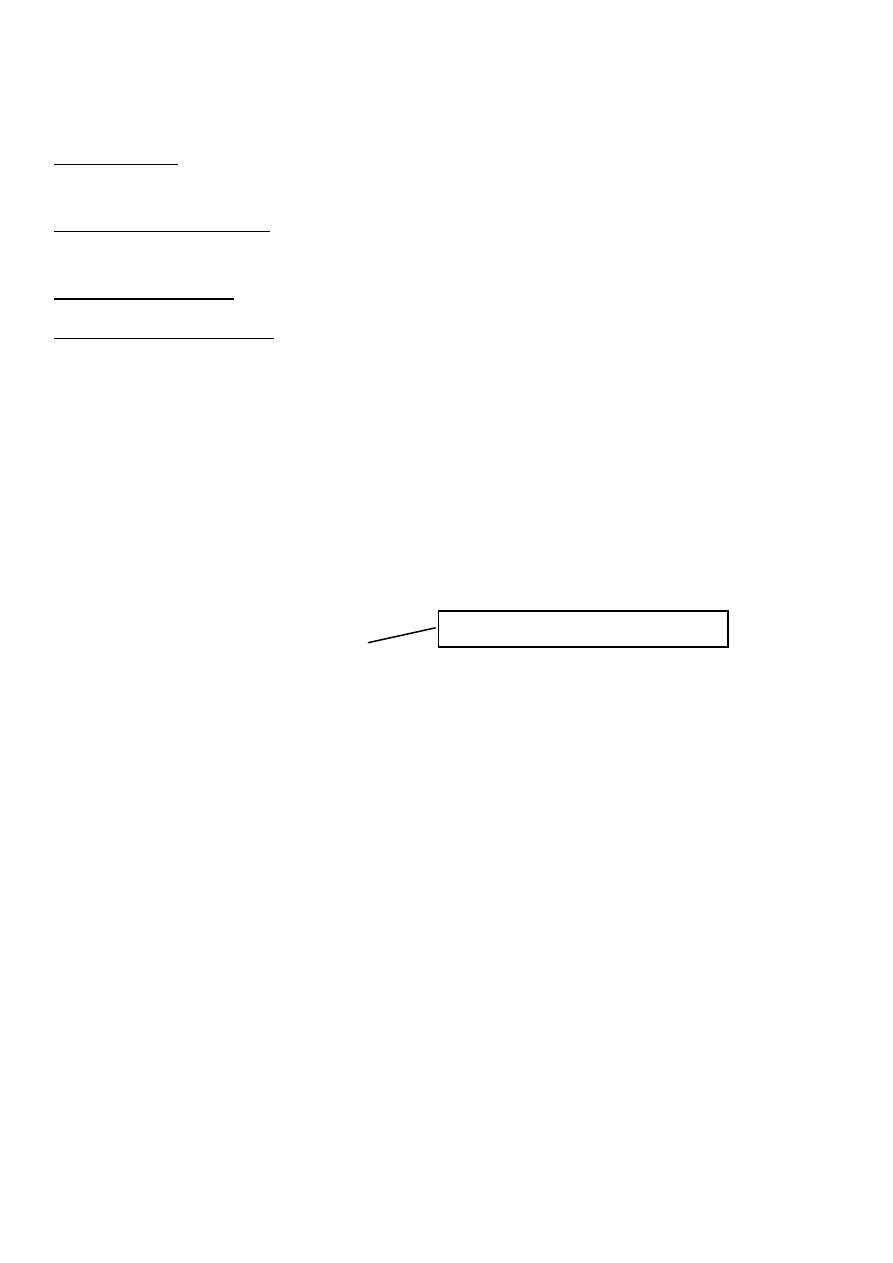
16
Types of Personality Theories:
Trait Theories: Attempt to learn what traits make up personality and how they relate to
actual behavior
Psychodynamic Theories: Focus on the inner workings of personality, especially internal
conflicts and struggles
Humanistic Theories: Focus on private, subjective experience and personal growth
Social-Cognitive Theories: Attribute difference in personality to socialization, expectations,
and mental processes
Part1:Trait Theories
Jung’s Theory of Two Types:
Carl Jung, Swiss psychiatrist who was a Freudian disciple, believed that we are one of two
personality types:
Introvert: Shy, self-centered person whose attention is focused inward
Extrovert: Bold, outgoing person whose attention is directed outward
Eysenck’s Three Factor Theory:
Hans Eysenck, English psychologist, believed that there are three fundamental factors in
personality:
Introversion VS Extroversion
Emotionally Stable VS Unstable (neurotic)
Impulse Control VS Psychotic
The first two factors create 4 combinations, related to the four basic temperaments
recognized by ancient Greeks:
Melancholic (introverted + unstable): sad, gloomy
Choleric (extroverted + unstable): hot-tempered, irritable
Phlegmatic (introverted + stable): sluggish, calm
Sanguine (extroverted + stable): cheerful, hopeful
Important: only understand it
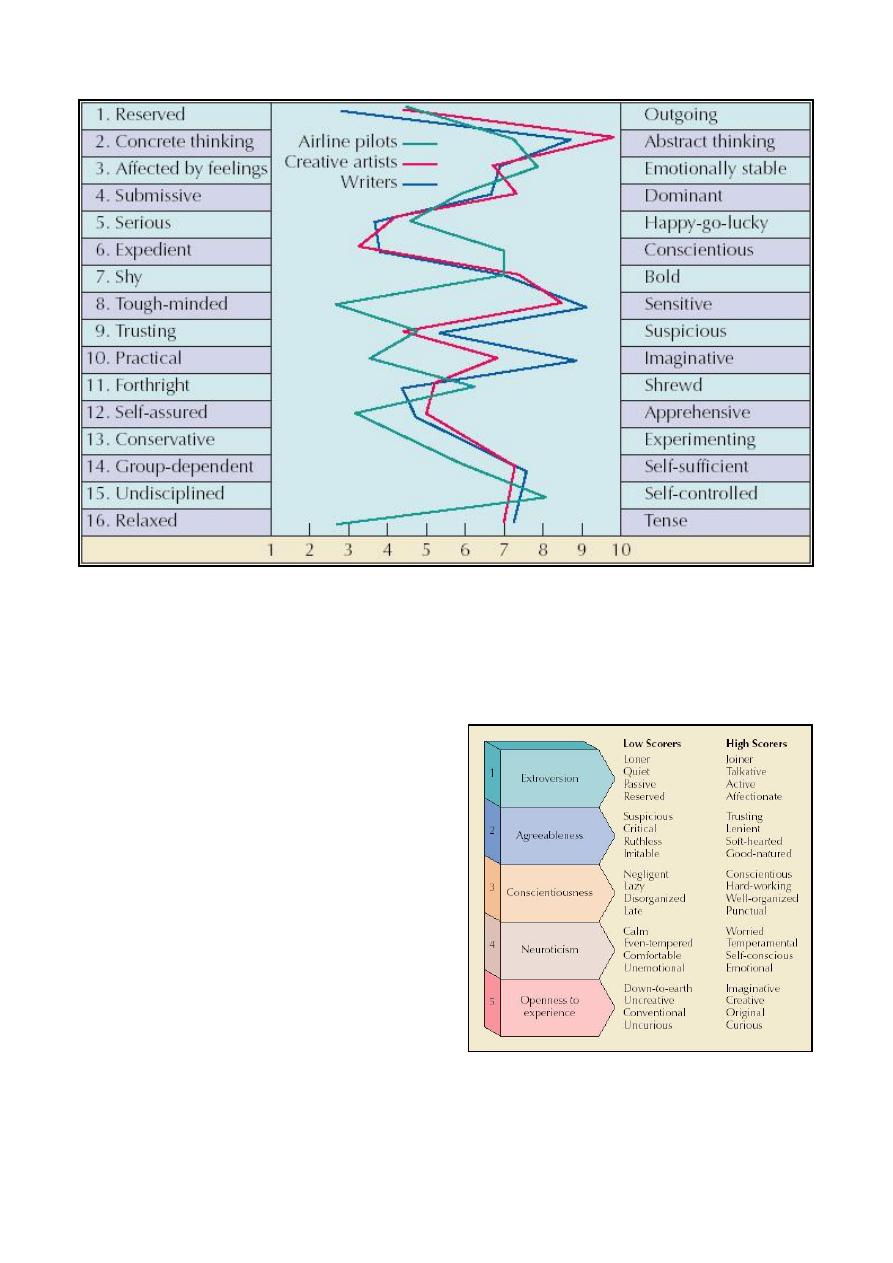
17
The Sixteen Personality Factors:
Cattell: The Big Five:
Cattell believed that five factors were most
important:
Openness
Conscientiousness
Extraversion
Agreeable
Neuroticism
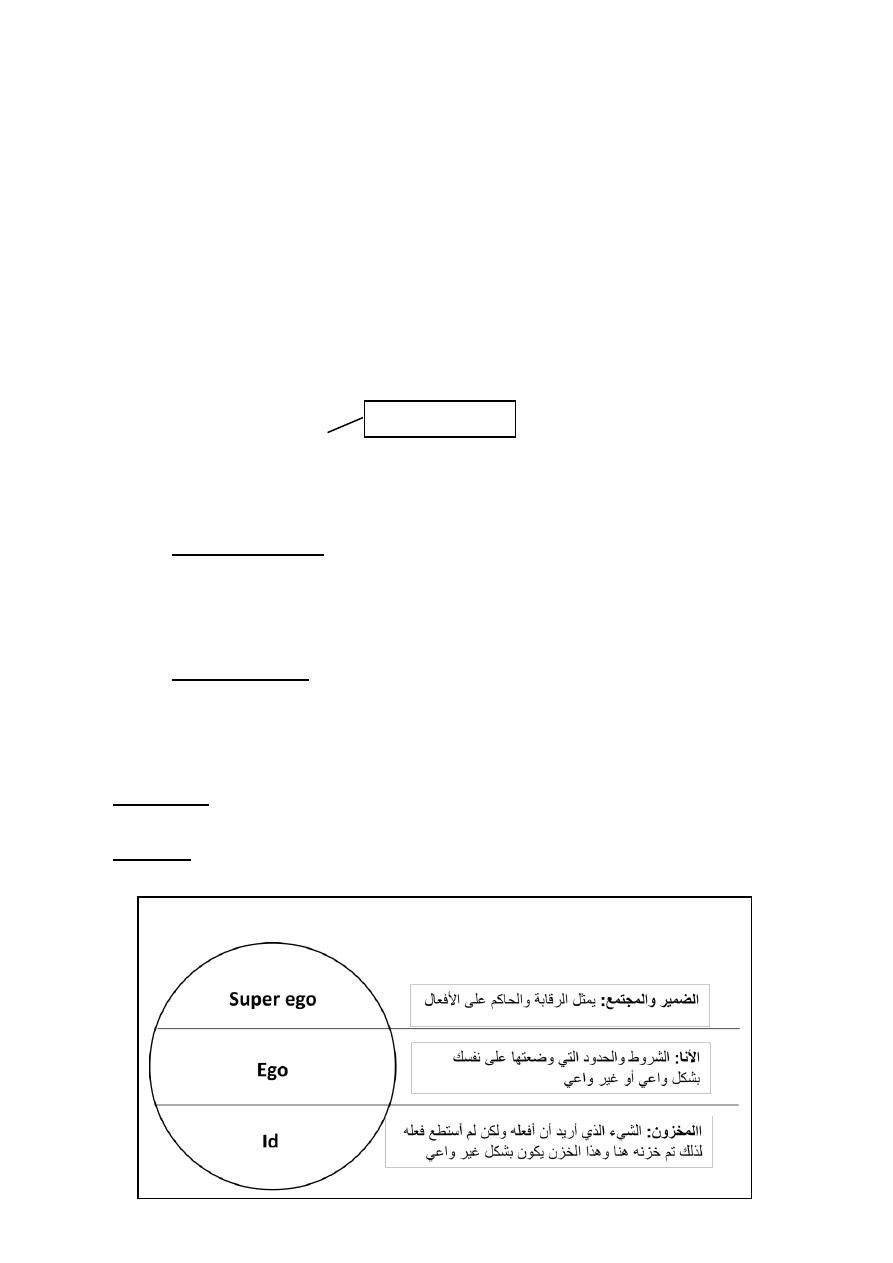
18
Part 2: Psychoanalytic Theory
Freud’s Psychoanalytic Theory
Sigmund Freud, M.D.,a Viennese physician who thought his patients’ problems were more
emotional than physical.
Freud began his work by using hypnosis and eventually switched to psychoanalysis.
Freud had many followers: Jung and Adler, to name a few.
More than 100 years later, his work is still influential and very controversial
The Id, Ego, and Superego:
Id: Innate biological instincts and urges; self-serving & irrational
Totally unconscious
Works on Pleasure Principle: Wishes to have its desires (pleasurable) satisfied NOW,
without waiting and regardless of the consequences
Ego: Executive; directs id energies
Partially conscious and partially unconscious
Works on Reality Principle: Delays action until it is practical and/or appropriate
Superego: Judge or censor for thoughts and actions of the ego
Superego comes from our parents or caregivers; guilt comes from the superego
Two parts:
o Conscience: Reflects actions for which a person has been punished (e.g., what we
shouldn’t do or be)
o Ego Ideal: Second part of the superego; reflects behavior one’s parents approved of
or rewarded (e.g., what we should do or be)
Important: all
Note:
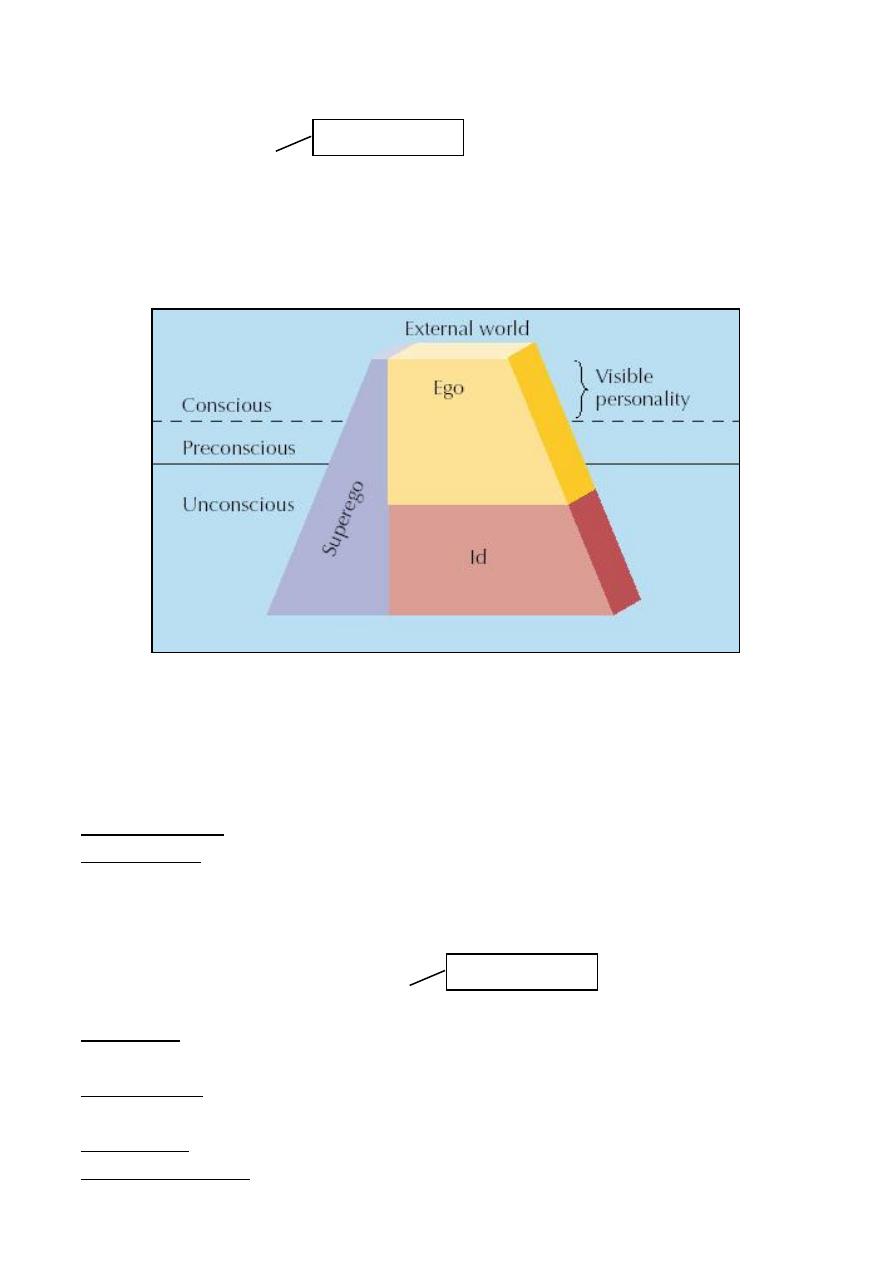
19
Levels of Awareness:
Conscious: Everything you are aware of at a given moment
Preconscious: Material that can easily be brought into awareness
Unconscious: Holds repressed memories and emotions and the id’s instinctual drives
Cause of Anxiety:
Ego is always caught in the middle of battles between superego’s desires for moral behavior
and the id’s desires for immediate gratification
o Neurotic Anxiety: Caused by id impulses that the ego can barely control
o Moral Anxiety: Comes from threats of punishment from the superego
Defense mechanism: a process used by the ego to distort reality and protect a person from
anxiety
Examples of Defense Mechanisms:
o Regression: Ego seeks the security of an earlier developmental period in the face of
stress.
o Displacement: Ego shifts unacceptable feelings from one object to another, more
acceptable object.
o Sublimation: Ego replaces an unacceptable impulse with a socially acceptable one
o Reaction Formation: Ego transforms an unacceptable motive or feeling into its opposite.
Important: all
Important: all
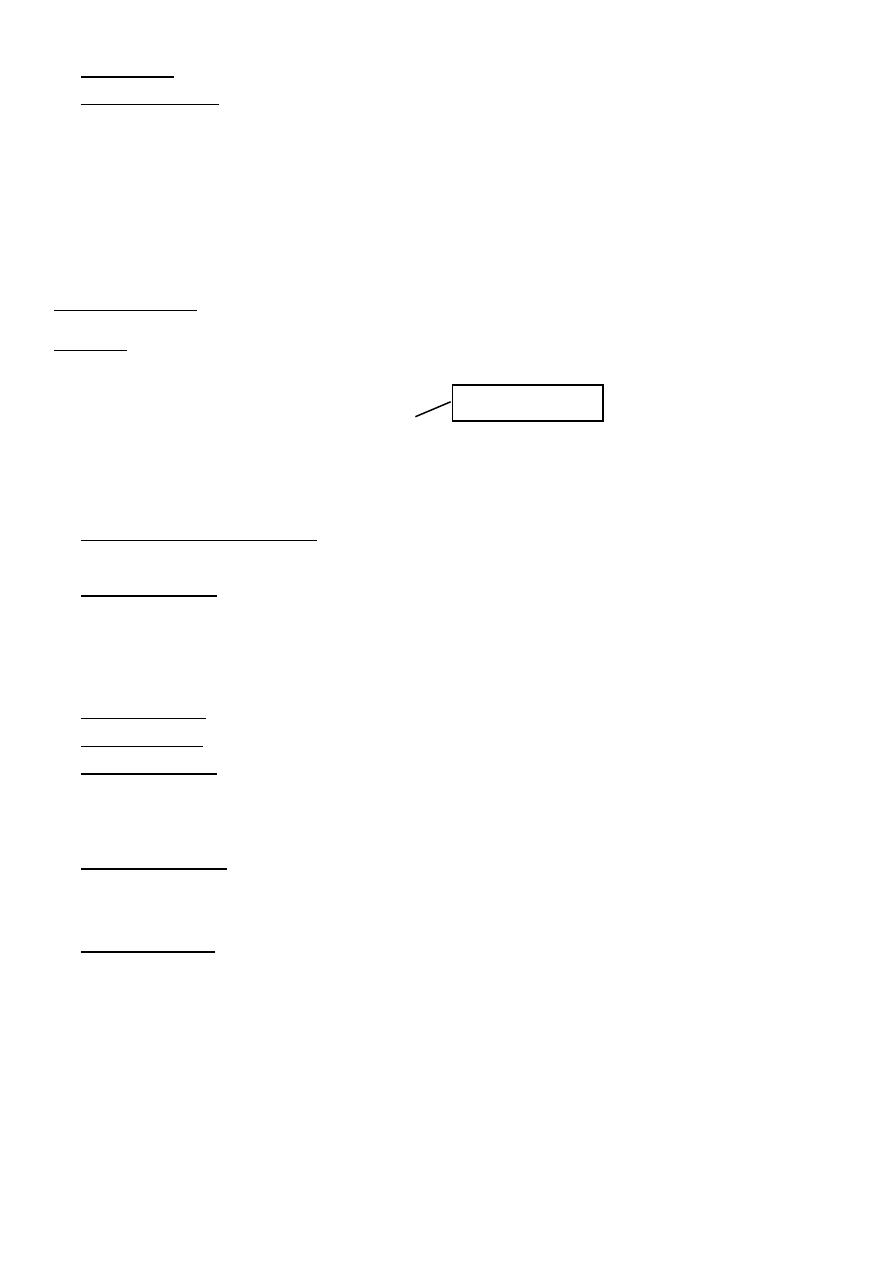
21
o Projection: Ego attributes personal shortcomings, problems, and faults to others.
o Rationalization: Ego justifies an unacceptable motive by giving a false acceptable (but
false) reason for behavior
Personality Development:
According to Freud, personality develops in stages; everyone goes through same stages in
same order. Majority of personality is formed before age 6
Erogenous Zone: Area on body capable of producing pleasure
Fixation: Unresolved conflict or emotional hang-up caused by overindulgence or frustration
Stages of Personality Development:
Oral Stage: Ages 0-1. Most of infant’s pleasure comes from stimulation of the mouth. If a
child is overfed or frustrated, oral traits will develop.
o Oral Dependent Personality: Gullible, passive, and need lots of attention. Fixations
create oral-aggressive adults who like to argue and exploit others.
o Erogenous zone: mouth (oral)
Anal Stage: Ages 1-3. Attention turns to process of elimination. Child can gain approval or
express aggression by letting go or holding on. Ego develops. Harsh or lenient toilet training
can make a child either:
o Anal Retentive: Stubborn, stingy, orderly, and compulsively clean
o Anal Expulsive: Disorderly, messy, destructive, or cruel
o Erogenous zone: anus
Phallic Stage: Ages 3-6. Child now notices and is physically attracted to opposite sex parent.
Can lead to:
o Oedipus Conflict: For boys only. Boy feels rivalry with his father for his mother’s
affection. Boy may feel threatened by father (castration anxiety). To resolve, boy must
identify with his father (i.e., become more like him and adopt his heterosexual beliefs).
o Electra Conflict: Girl loves her father and competes with her mother. Girl identifies with
her mother more slowly because she already feels castrated.
Erogenous zone: phallus
Latency: Ages 6-Puberty. Psychosexual development is dormant. Same sex friendships and
play occur here.
Genital Stage: Puberty-on. Realization of full adult sexuality occurs here; sexual urges re-
awaken.
Important: all
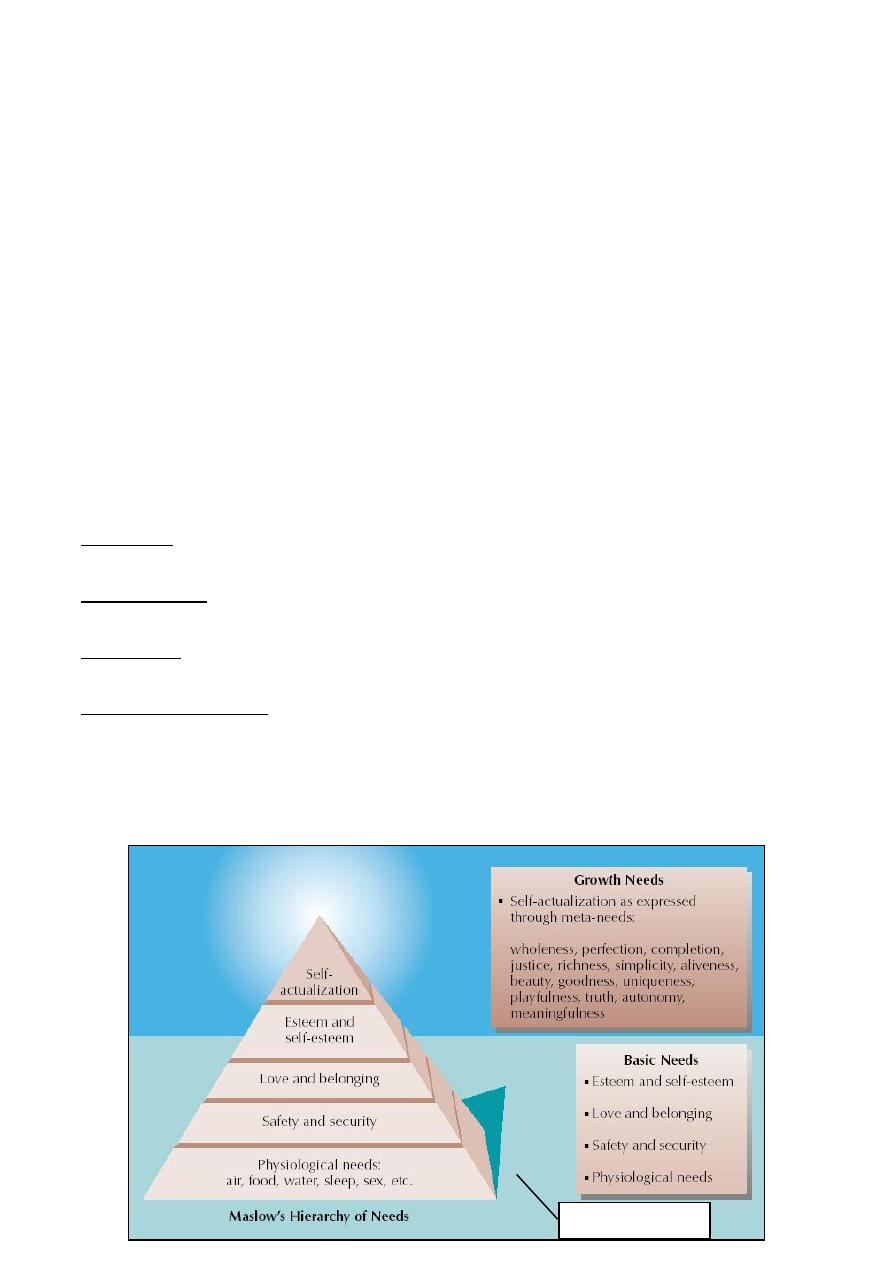
21
Part 3:
Evaluation of Social-Cognitive Theories
Social-cognitive theories tend to be overly-mechanical.
Overemphasizes environmental influences; gives little or no consideration to the
possibility of innate personality differences or the effects of genetics.
Does not recognize internal human qualities such as hope, aspiration, love, self-
sacrifice
Part 4: Humanistic Theories
Humanism:
Humanism: Approach that focuses on human experience, problems, potentials, and
ideals
Human Nature: Traits, qualities, potentials, and behavior patterns most characteristic of
humans
Free Choice: Ability to choose that is NOT controlled by genetics, learning, or
unconscious forces
Subjective Experience: Private perceptions of reality
Graphic: Hierarchy of Needs
Important: all

22
Characteristics of Self-Actualized People
Efficient perceptions of reality
Comfortable acceptance of self, others, and nature
Spontaneity
Task Centering
Autonomy
Continued freshness of appreciation
Fellowship with humanity
Profound interpersonal relationships
Comfort with solitude
Non-hostile sense of humor
Peak experiences
Important: all
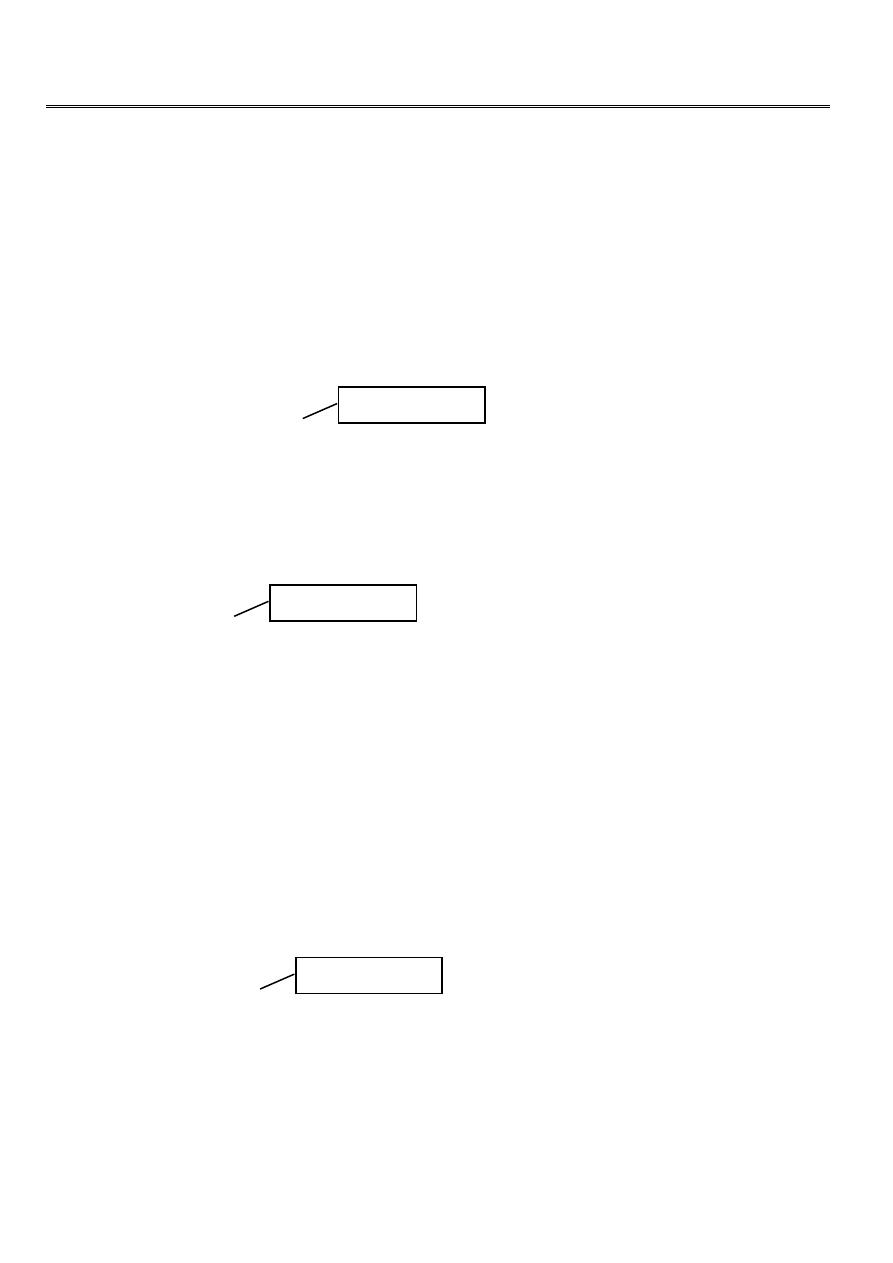
23
4th stage
Intelligence
Lec-5
ا.د.الهام
الجماس
5/10/2015
Definition
The ability to assimilate factual knowledge to recall either recent or remote events, reason
logically, to manipulate concepts, to translate the abstract to the literal to the abstract, to
analyze and synthesize forms , and to deal meaningfully and accurately with problems and
priorities in particular setting some psychologist describe many types of intelligence like
academic , musical , social ….. etc.
Or intelligence: is verbal ability, problems solving skills & the ability to adapt & learn from
lifes every day experiences.
The Intelligent quotient:
The intelligent (IQ) is the ratio of (MA) to CA (Chronological age multiplied by 100)
IQ=MA/C*100
An IQ of 100 or average result when chronological and mental age are equal.
Mental age (MA):
Is an individual level of mental development & intellectual level of particular age, relative to
others.
MA was firstly introduced by a French psychologist called AlferdBinet
Binet test:
L A scale consisted of 30 items ranging from the ability to touch ones nose or ear whem
asked to the ability to draw signs from memory & define abstract concepts the age of
children were 3-11 years
Mental retardation:
Is inadequate intellectual functioning in which the individual IQ usually below 70, has
difficulty adapting to everyday life & has onset of these characteristics during the
developmental period i.e by the age of 18
Mild: 55-70 about 89% of mental retardation
Moderate: 40-54 6%
Important: all
Important: all
Important: all

24
sever M.R: 25-30 3-5%
profound: below 25 1%
Giftedness:
Gifted have above average intelligence (I.Q 120 or higher)
Creativity:
Is the ability to think about something in usual ways & came up with unique solution to
problems thus intelligence & creativity are not the same thing
Some important facts about intelligence:
Many factors could contribute to the individual differences level but culture & ethnicity
& IQ test bias due to linguistic, economical & educational differences.
Mental ability tends to increase up to the age of 26, level off for the next 10 years , and
then decline after age 49 but recent research proved that IQ is increasing all over the
world due to positive environmental influences through stimulation & communication.
The most useful intelligence test must measure a variety of skills and abilities including
verbal – performance timed untimed culture free culture bound early learned late
learned,.
Test measure present functioning ability not necessarily of future potential
Intelligence tests:
Any type of test must be valid and reliable
Reliability:
Tell us whether test scores are consistent over times
Validity:
Tell us how well a test measures what is intended to measure
Important: all
Important: all
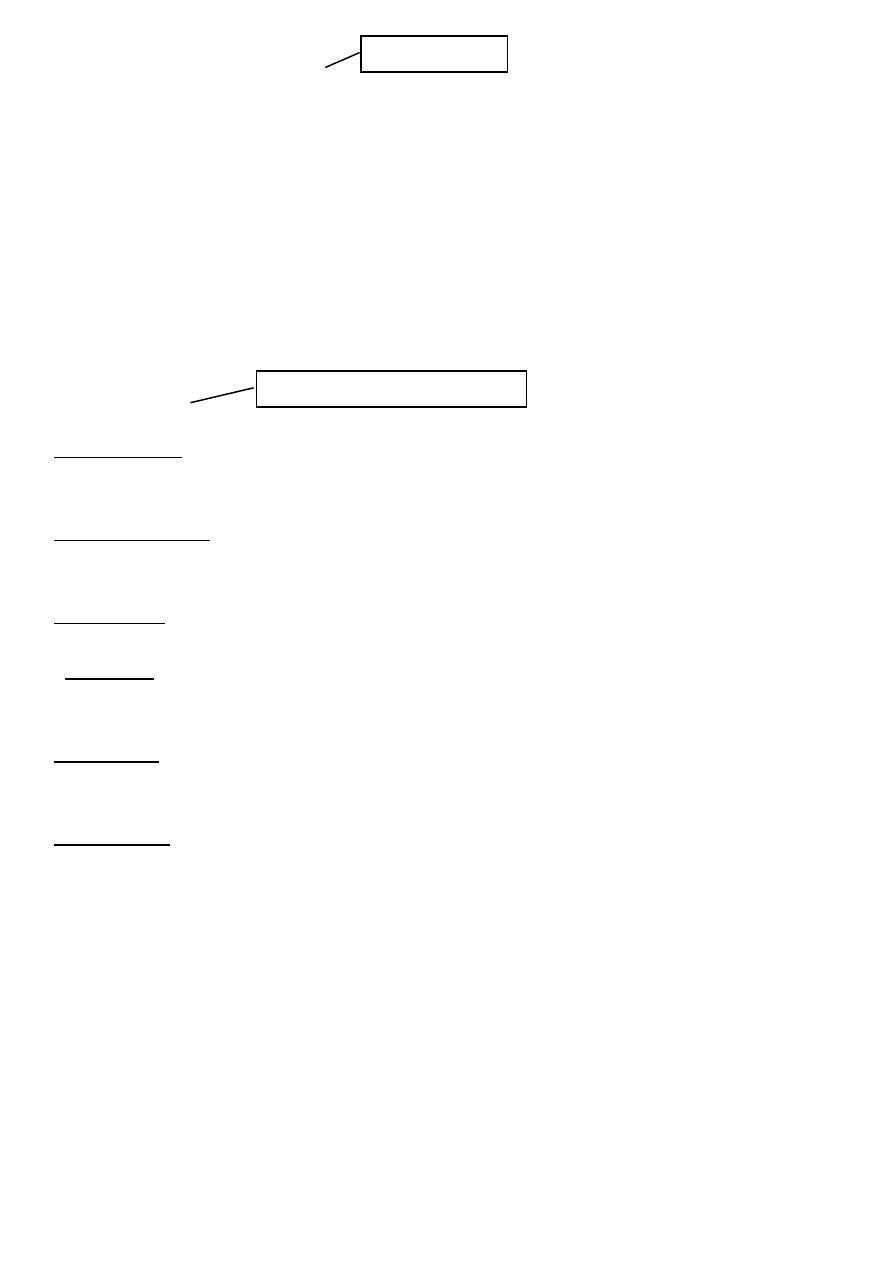
25
Wechsler intelligence test:
Constructed by David Wechsler at New York University in 1939 the original test gone
through several revisions the latest revision is lll
WAIS lll: is designed for person 16-89
WISC lll: (Wechsler intelligence scale years for children) designed for age 5-15
WPPSI-R:(Wechsler preschool and primary scale of intelligence - Revised) for children of 4-6
Construction of the test: WAIS comprises ll sub tests made up to six-verbal and 5
performance sub tests, for which there is verbal IQ.
Verbal skills:
1. Information: this sub tests covers general information and knowledge and is subject to
cultural variables. Persons from low socioeconomic groups with little schooling don't
perform as well as those from high socioeconomic groups with more schooling
2. Comprehension: this sub test measures subjects knowledge of social conventions and
common sense and examines qualities of person's reasons ought to behave under certain
circumstance
3. Arithmetic: the ability to do arithmetic and other simple calculations is reflected on this
sub test which is adversely influenced by anxiety and poor attention and concentration.
4. Similarity: This sub test is a sensitive indicator of intelligence it covers the ability to
abstract by asking subjects to explain the similarity between two things e.g.: in what ways
are the boat & the trains the same.
5. Digit span: immediate retention is measured in this sub test subject are asked to learn a
series of two to nine digits, which are immediately recalled both forward and backward,
anxiety, poor attention span , and brain dysfunction interfere with recall.
6. Vocabulary: subjects are asked to define 35 vocabulary words of increasing difficulty,
intelligence has a high correlation with vocabulary, which is related to level of education
idiosyncratic definitions of words may give clues to personality structures.
Important: all
Important: enumerate only
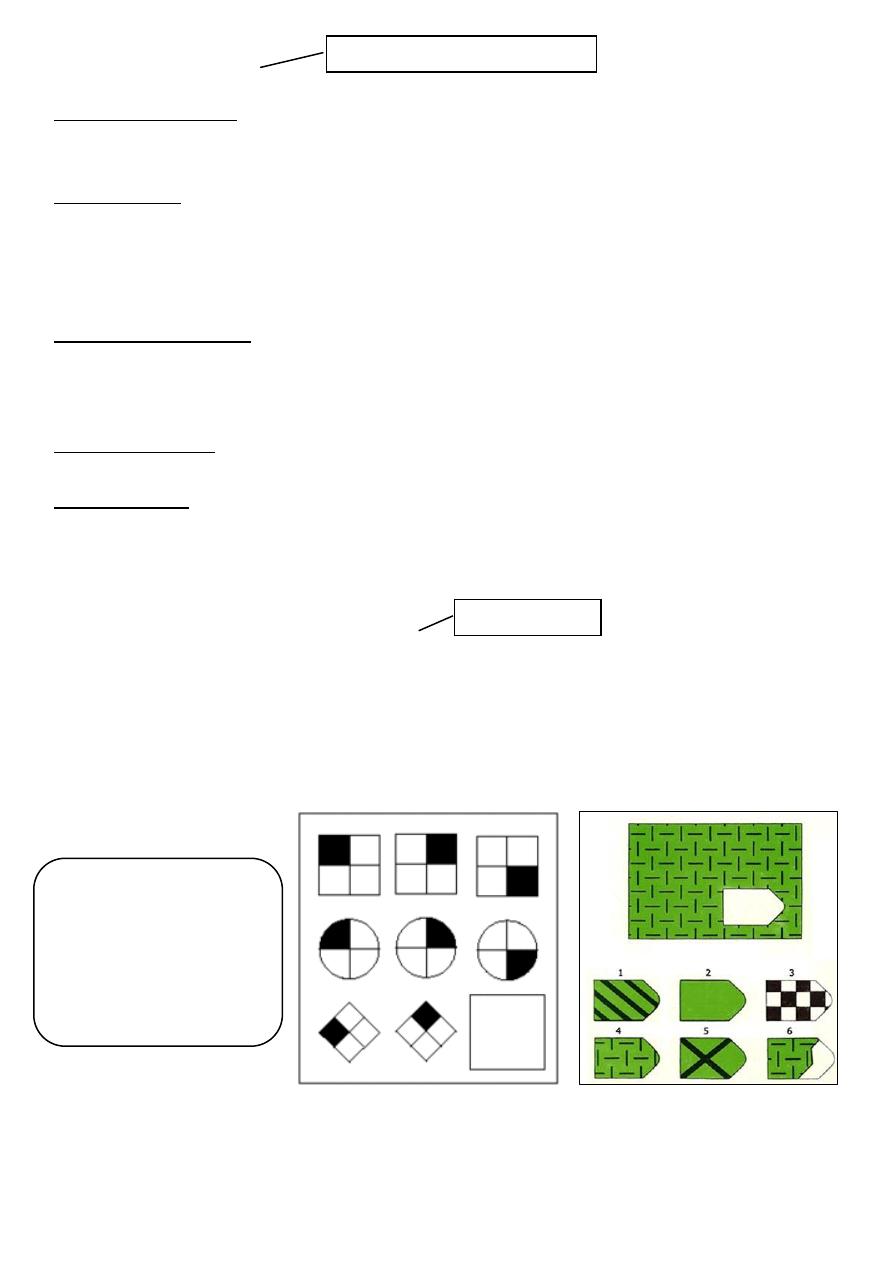
26
Performance:
1. Picture completion: this sub test initiates the performance part of the WAIS and consists
of completing a picture in which a part is missing visuo-perceptive defects become evident
when mistakes are made on this test
2. Block design: this sub tests requires subjects to match colored blocks and visual designs
brain dysfunction involving impairment of the left right dominance interferes with
performance e.g : an individual must assemble a set of multicolored blocks to match
designs that the examiner shows visual motor coordination , perceptual organization and
the ability to visualize spatially are assessed
3. Picture arrangement: subjects are require to arrange a series of pictures in a sequence
that tells a story ( e.g. a person committing a crime in addition to testing performance this
subtest provide data about a subjects cognitive style this sub scale evaluate how individuals
integrate information to make it logical and meaningful
4. Object assembly: subjects must assemble objects such as the figure of a women or an
animal in the proper order and organization visuo-perception.
5. Digit symbols: in this final subtest of the WAIS subjects receive a code that pair symbols
with digit the test consist of matching a series of digits to their corresponding symbols in as
little time as possible.
RAVEN Progressive Matrices IQ Test
Consist of 5 groups A,B,C,D,E each group consist 12 design of matrices in progressive
difficulties.
Each matrix contains a series of picture with a missing piece and the candidate has to select
the right answer from a number of correct answers and age
Important: enumerate only
Important: all
Note: RAVEN test:
Color test for less than
15 years
Black & white test for
adult
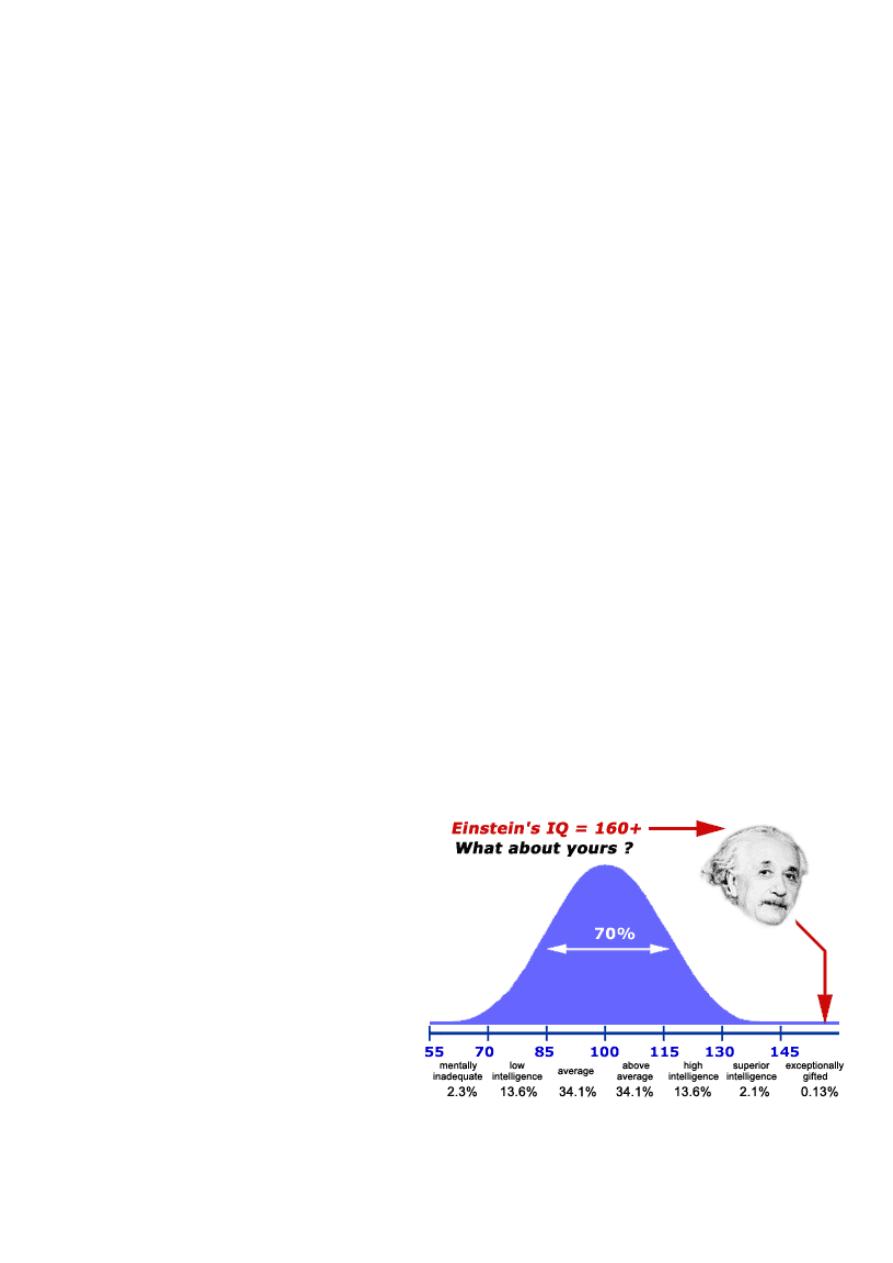
27
Other Tests
performance test
* Koh's block
The subject has to construct designs with the block according to given pattern of increasing
difficulty the result is usually expressed as mental age (MA) or IQ
* Domino Test
* Maze test
* Picture completion tests
Advantage of performance tests
1. Can be used on illiterate, foreigners, deaf mute and those with speech difficulties.
2. Less determines by education than verbal tests
Disadvantages
1. Usually take a long time to do
2. The norms are different according to cultures.
Verbal tests:
Mostly consisting of series of short questions arranged in a progressive difficulties
according to mental ages there is a battery of question
*Binet test
* spearman approach
* Kent test
The extreme of intelligence are represented by: mentally subnormal at one end of the
scale, and the intellectually gifted at the
other.
IQ Classification %
>129 very superior 1%
120-129 superior 11%
110-119 High average 18%
90-109 average 46%
80-89 low average 15%
70-79 borderline 6%
<70 mentally sub. 3%
(Subnormal: then IQ is below standard according to its severity, while mentally gifted IQ is
above standard and show superior attainment throughout childhood and adult life)

28
Practical uses of intelligence tests
1. Educational: * Selection of pupils for special groups: like schools classes or institutes
2. Researches: e.g. relationship between IQ and personality and behavior
3. Military service
4. Committees
* medical: (fitness for job or study)
* Courts and police (criminal responsibility)
Important: all
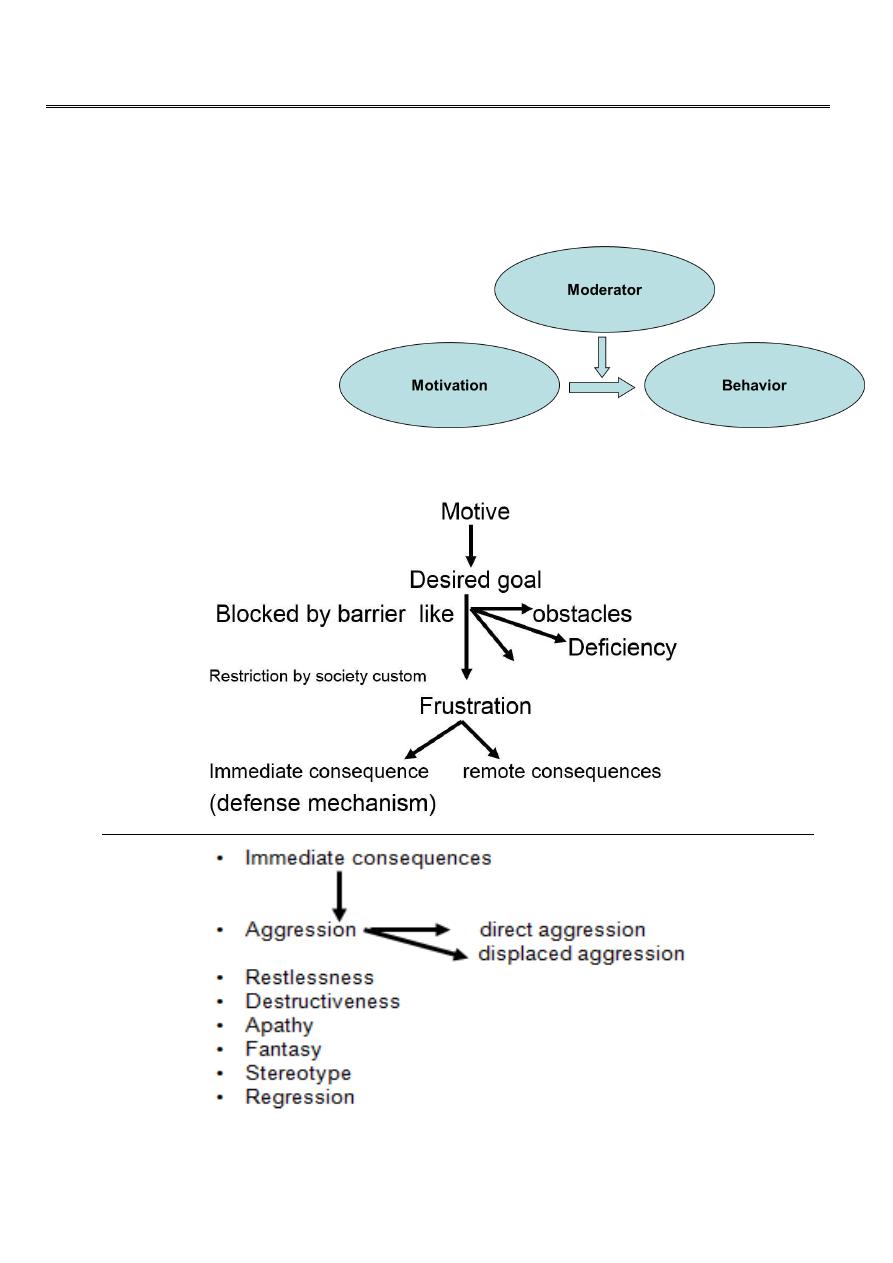
29
4th stage
Motivation
Lec-6
ا.د.الهام
الجماس
6/10/2015
What is motivation?
Coming from the Greek word “movere” which means to move, motivation involves the
question of why people behave, think and feel the way they do.
Motivational Moderators
Influence the impact of
motivation on behavior

31
What is motivation?
Motivation is having the desire and willingness to do something (e.g. becoming a
professional; learning how to ride a bike)
What are the characteristics of a motivated behavior?
Energized to do or engage in an activity.
Directed towards reaching a specific goal.
Sustained and intensified feelings about reaching that goal.
What are the kinds of motives?
Basic or Primary Motives
1. Need to adjust to temperature
2. Need to quench thirst
3. Need to satisfy hunger
4. Avoidance of pain
5. Need for sensory stimulation
6. Need for sex
Acquired or Secondary
1. Need to belong
2. Need for love
3. Need for achievement
4. Need to be nurtured
5. Need for safety
Important: all
Important: all

31
Theories of Motivation
The Biological Influences
I. INSTINCT THEORY
William McDougall (1908): Humans are motivated by a number of different instincts
(e.g. curiosity, self-assertion).
Instincts—are innate tendencies or biological forces that determine behavior; they are
assumed to be universal throughout species.
Instincts are now redefined as fixed action pattern—an innate biological force that
predisposes an organism to behave in a fixed way in the presence of a specific
environmental condition
II. DRIVE-REDUCTION THEORY
Key Components:
Need—a biological state in which the organism lacks something essential for survival
(e.g. food, water, oxygen); a deprivation that energizes the drive to eliminate or reduce
the deprivation.
Drive—a state of tension produced by need that motivates the organism to act to
reduce that tension.
Why would the organism want to reduce the tension? To go back to a state of
homeostasis—once the need is satisfied, the body returns to a more balanced state or
equilibrium.
DRIVE-REDUCTION THEORY: A need results in a drive, which is a state of tension that
motivates the organism to act to reduce the tension and return the body to
homeostasis.
The Behavioral and Socio-Cultural Influences
III. INCENTIVE THEORY
Incentives—are environmental factors, such as external stimuli, reinforcers or rewards
that motivate our behavior.
Examples: grades, recognition, money, fame
Because incentives are external, they are thought of as pulling us to obtain them;
whereas drives are internal, they are thought of as pushing us to obtain them. Hence,
incentives and drives are the pull and push of our behavior.
Important:
Enumerate
Definitions

32
The Cognitive Influences
IV. COGNITIVE THEORY
Extrinsic motivation—involves engaging in certain behaviors or activities because of
incentives or external rewards
Intrinsic motivation—involves engaging in certain behaviors or activities because the
behaviors themselves are personally rewarding or because engaging in these activities
fulfills our beliefs or expectations.
In summary:
The theory of fixed action patterns (instinct) explains the behavior of animals.
The drive-reduction theory (a pushing forced) explains our actions to meet biological or
physiological needs.
The incentive theory (a pulling force) explains why we do things to obtain external
rewards.
The cognitive theory explains that we do things to satisfy personal beliefs or meet
personal goals.
The Humanistic Approach
Maslow’s Hierarchy of Needs:
Abraham Maslow believed that our needs are arranged in a hierarchy.
We satisfy our biological needs first before we turn our attention and energy to fulfilling
personal and social needs.
Maslow’s hierarchy of needs is represented by a pyramid and shows the order in
satisfying biological and social needs.
Two Kinds of Needs:
Biological needs—are physiological requirements that are critical to our survival and
physical well-being.
Examples: food, water, oxygen, sleep, avoidance of pain and sex
Social needs—are needs that are acquired through learning and experience.
Examples: affiliation, nurturance, play, dominance, achievement

33
Level 1. Physiological needs
Physiological needs—includes food, water, sleep, sex, etc. necessary for basic survival.
Examples: People who are homeless would be especially concerned with satisfying their
physiological needs.
Level 2. Safety and security needs
Safety and security needs—the need for protection from harm.
Examples: People who live in dangerous communities will be concerned about satisfying
their safety needs.
Level 3. Love and belongingness needs
Love and belongingness needs—the need for affiliation and acceptance by others.
Examples: Adolescents and young adults who are beginning to form serious
relationships would be interested in satisfying their need for love and belongingness.
Important: all
Important: all

34
Level 4. Esteem needs
Esteem needs—the need for achievement, competency, gaining approval and
recognition.
Examples: During early and middle adulthood, people are concerned with achieving
their goals and establishing their careers.
Level 5. Self-actualization needs
Self-actualization needs—the need to fulfill one’s unique potential as a human being;
this is the highest and most elusive kind of need and because it is difficult and
challenging, only a few individuals are able to reach this level.
REFLECTION: What motivates me most?
• Write a short reflection paper on the things that motivate you most:
– To achieve
– To love
– To go on with your life
• Rank the following list of values in terms of how important are they as your guiding
principles :
– A comfortable life
—An exciting life
– A sense of accomplishment
—A world at peace
– A world of beauty
—Equality
– Family security
—Freedom
– Happiness
—Inner harmony
– Mature love
—National security
– Pleasure
—Salvation
– Self-respect
—Social recognition
– True friendship
—Wisdom

35
4th stage
Emotion
Lec-7
ا.د.الهام
الجماس
6/10/2015
Emotion:
Is the feeling which are experience in an intense fashion, or feeling states that are aroused
by certain actions. Fear, rage, hate, lone all these are motional responses
Limbic system
Play an important part in emotion. It composed of the following structures:
1. Primary olfactory complex.
2. Sebtal cortex.
3. Hypocampal gyrus.
4. Cingulate gyrus.
5. Subcallosal gyrus.
It is closely related to emotion, it is not found in organism lower than mammals.
The instinctive activities of birds as feeding, flying from fear is achieved by limbic system
which is build upon Hypothalamic mechanism which direct the organism and led the
organism engaged in series of activities depending on its adaptive activities .
Any emotion experienced is accompany by a general excitation of autonomic nervous
system .
The evidence suggest that emotional reaction depend upon the physiological arousal.
All psychologists classify emotions into those that are pleasant (joy, love) and those are
unpleasant (anger, sadness.)
Other classification according into intensity provided by emotional term word pairs such
Anger- rage
Sadness- grief.
Fear – horror.
Pain- agony .
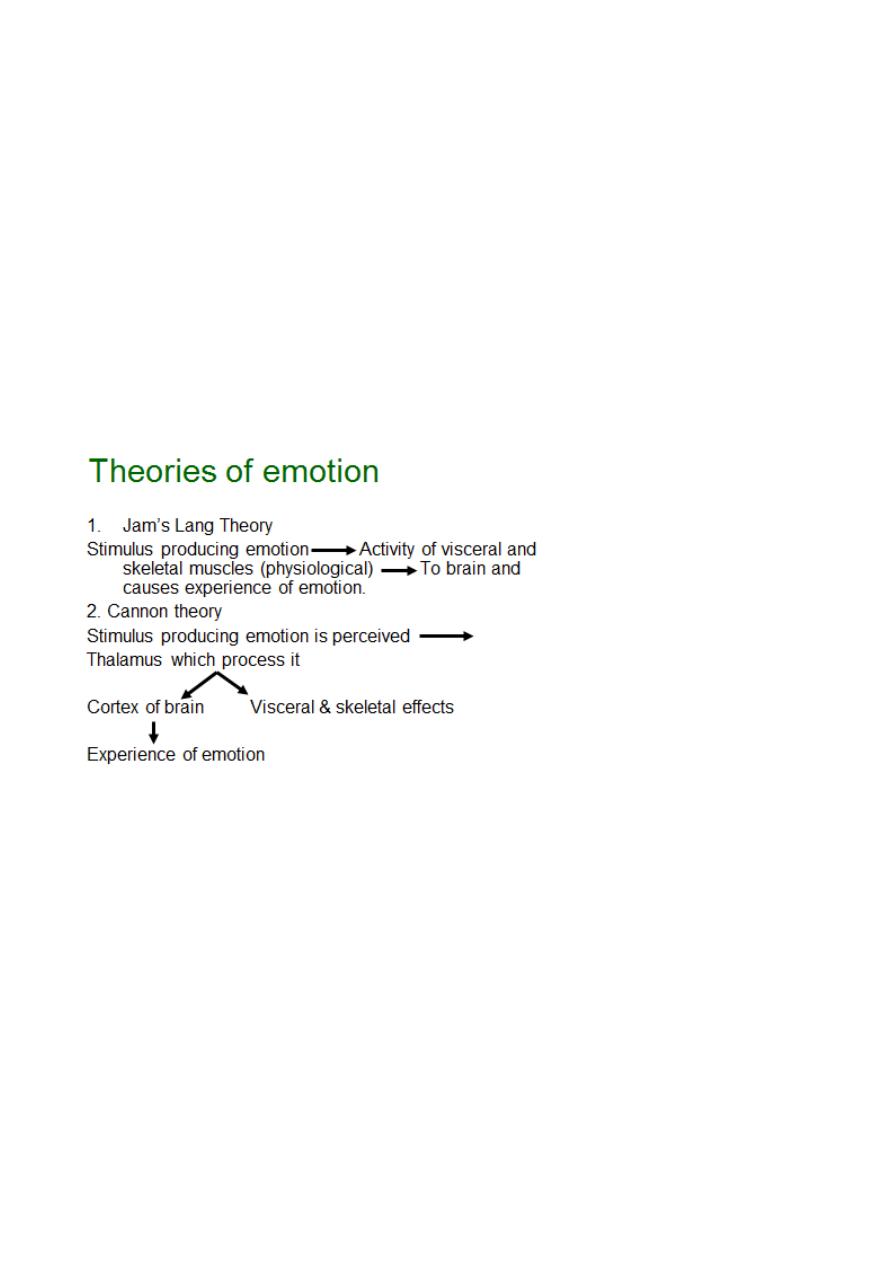
36
Brain mechanism in emotion
The central nervous system control the skeletal muscles which is responsible muscular
activity.
The autonomic system and endocrine glands control the flow of adrenaline, the
acceleration of the heart and other visceral response pattern. The tear in laughter and
weeping are controlled by the A.N.S and vocal & facial muscles by C.N.S .
There is evidence that the Hypothalamus play a central role in the organization and
activation of many types of emotional behaviour.
The limbic system also involved in emotion.
the reticular activating system play a role in emotion.
3
. Cognitive Theory: include three factors
1. Stimulus factor.
2. Cognitive factor.
3. Physiological factor.

37
Physiological differentiation
The evidence has shown that strong emotion as violence have been associated with the
disturbances of the body for this reason an attempt to differentiate emotions on the bases
of bodily responses. e.g if the face flushed in anger and pail in fear this would be a
convenient way to describe the difference between anger and fear.
These findings on the differences between fear and anger are supported by the study of
adrenal medullas of wild animals .
The chemical study of the blood has showed that secretion of Nore-adrenaline and
adrenaline associated with expression of anger and fear.
Other evidence showed that one pattern of response may be quite consistent within
individual but differ sharply from one person to another .
Aggression as an emotional reaction
Emotion may causes not only general reaction but also specific action like we may laugh
when happy, withdraw when frightened, aggression when angry.
At a social level the significance of aggression, a single aggressive act can produce
disaster.
at an individual level many people experience aggressive thoughts and impulses and
how they handle these thought will have an effect on their health and interpersonal
relations .
Aggression as drive
الحافز
According to Freud early psychoanalytic theory many of our actions are determined by
Instincts particularly sexual instinct, when expression of these instinct is frustrated an
aggressive drive is induced or whenever person’s effort to reach any goal is blocked an
aggressive drive is induced that motivated behaviour to injure the obstacle person or object
causing the frustration .

38
Emotional development
Emotion develops through both maturation and learning the infant is born with the
capacity to cry and the capacity to laugh comes through maturation.
The child has to learn not only the occasions for emotion but how to control emotional
expression according to patterns considered proper in his culture. The child learn to
distinguish among pleasant smile, a gentle laugh and a loud one.
Through the study of emotional responsiveness it appears that characteristic forms of
emotion as well as many of the actions that indicate emotion to us are essentially inborn
and develop without any special learning.
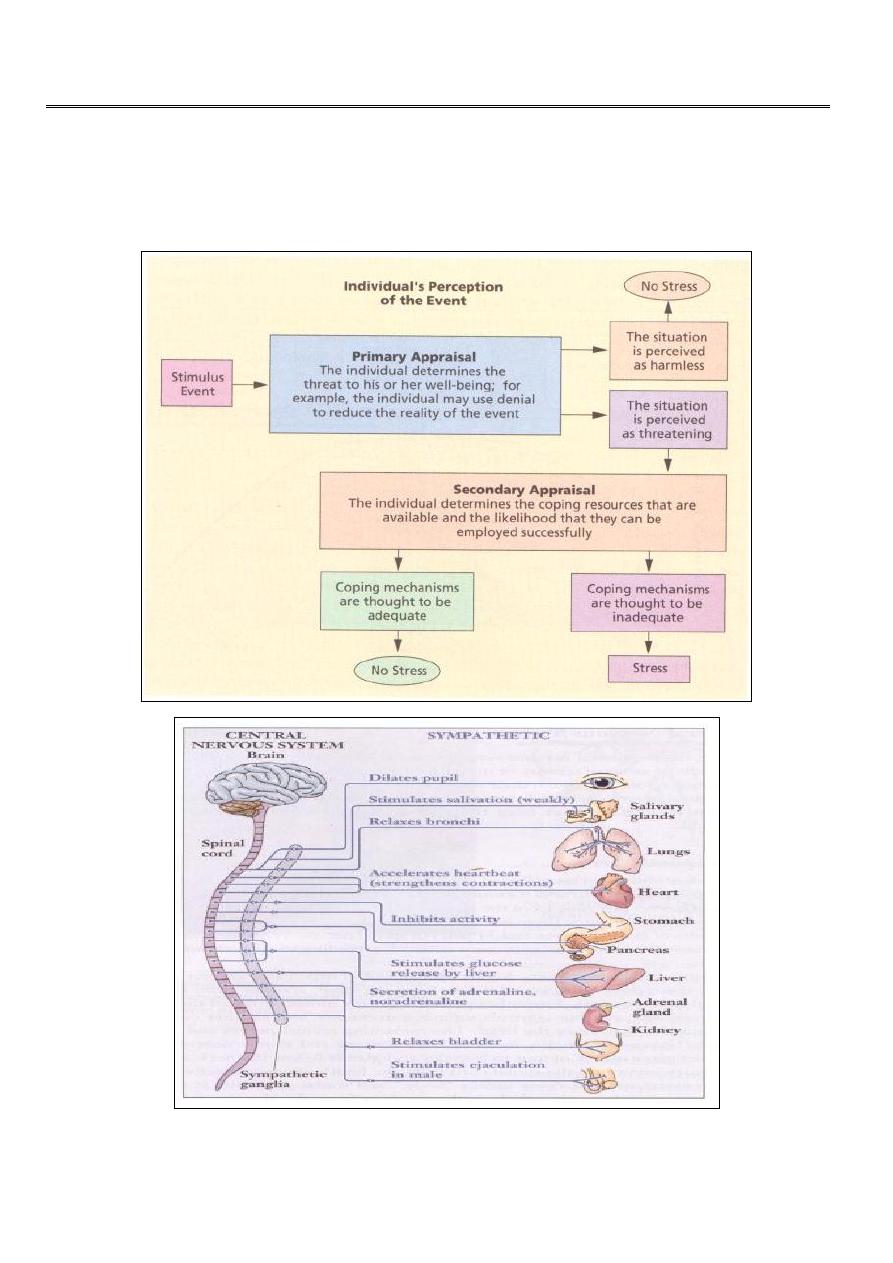
39
4th stage
Stress and Coping
Lec-8
ا.د.الهام
الجماس
5/10/2015
Stress:
A state of physical and/or psychological arousal
Often brought about by a perceived threat or challenge
May be expressed differently by different cultures

41
Stress Reaction Phases:
1. Acute phase Lasts minutes, hours or days
2. Reaction phase Lasts one to six weeks
3. Repair phase Lasts one to six months
4. Reorientation phase Approximately six months after a distressing event & continuing
Acute Phase
Lasts minutes, hours or days
“Fight or flight” response: preparation for physical activity
Narrowing of focus: decreases ability to think properly
Emotional reactions: disbelief/consternation/fear/grief
Rigid behavior: irritability, anger, etc. affects communication
Panic is rare but if present, requires immediate attention
Reaction Phase
Lasts one to six weeks
Delayed reactions: previously repressed or denied feelings will surface
May be overwhelming, bringing feelings of powerlessness
Reaction Phase: Characteristic reactions:
Fear of returning to the site of the event
Dreams or nightmares
Anxiety, restlessness, insomnia
Muscular tension, tremors and exaggerated startle response
Increased irritability and isolation, depression
Disturbing thoughts about survival, relief, guilt and grief
Perceived images of how others suffered in the disaster, i.e. how they died, how they
injured
Important: enumerate and time

41
Repair Phase
Lasts one to six months
Reactions are less intense, and not so overwhelming
o Feelings of hurt continue, but are more manageable
o Renewed interest in everyday life
o Makes plans for the future
Reorientation Phase
Approximately six months after a distressing event and continuing
Heightened stress reactions are substantially reduced
o Grief reaction may not be resolved but is accepted
o Most reactions will diminish gradually
Assessing ongoing needs is important
Coping with Stress
Coping is a way to prevent, delay, avoid, or manage stress
Coping mechanism categories:
o Changing the source of stress
o Changing the view of the situation
o Tolerating the stressor until it passes or becomes less troublesome
Loss and Grief
Loss is a common theme in most disaster settings
Common reactions to loss:
o Denial, numbness or shock
o Bargaining
o Depression
o Anger
o Acceptance
o Reorientation
Loss and Grief – Signs of Trouble
Avoiding or minimizing emotions
Using alcohol or drugs to self-medicate
Using work or other distractions to avoid feelings
Hostility and aggression toward others
Important: all

42
Emotional Numbness or Extreme Agitation
Immediate attention is needed
Possible referral for professional care
When referring:
o Inform the person of your intention
o Recognize that the referral may cause a negative reaction
Guiding Principles in Providing Psychological Support
First protect from danger
Focus on physical and material care
Be direct, active and remain calm
Focus on the “here and now” situation
Provide accurate information about the situation
Assist with mobilization of resources
Do not give false assurances
Recognize the importance of taking action
Reunite with family members
Provide and ensure emotional support
Focus on strengths and resilience
Encourage self-reliance
Respect feelings and cultures of others
Crisis Intervention
Observe safe practices by showing concern for your own safety
Remain calm and appear relaxed, confident and non-threatening
Crisis Intervention Steps
1. Assess the situation
2. Establish rapport
3. Identify the main problem (s)
4. Deal with feelings and emotions
5. Generate and explore alternative coping strategies
6. Formulate an action plan
7. Follow up
Important: definition
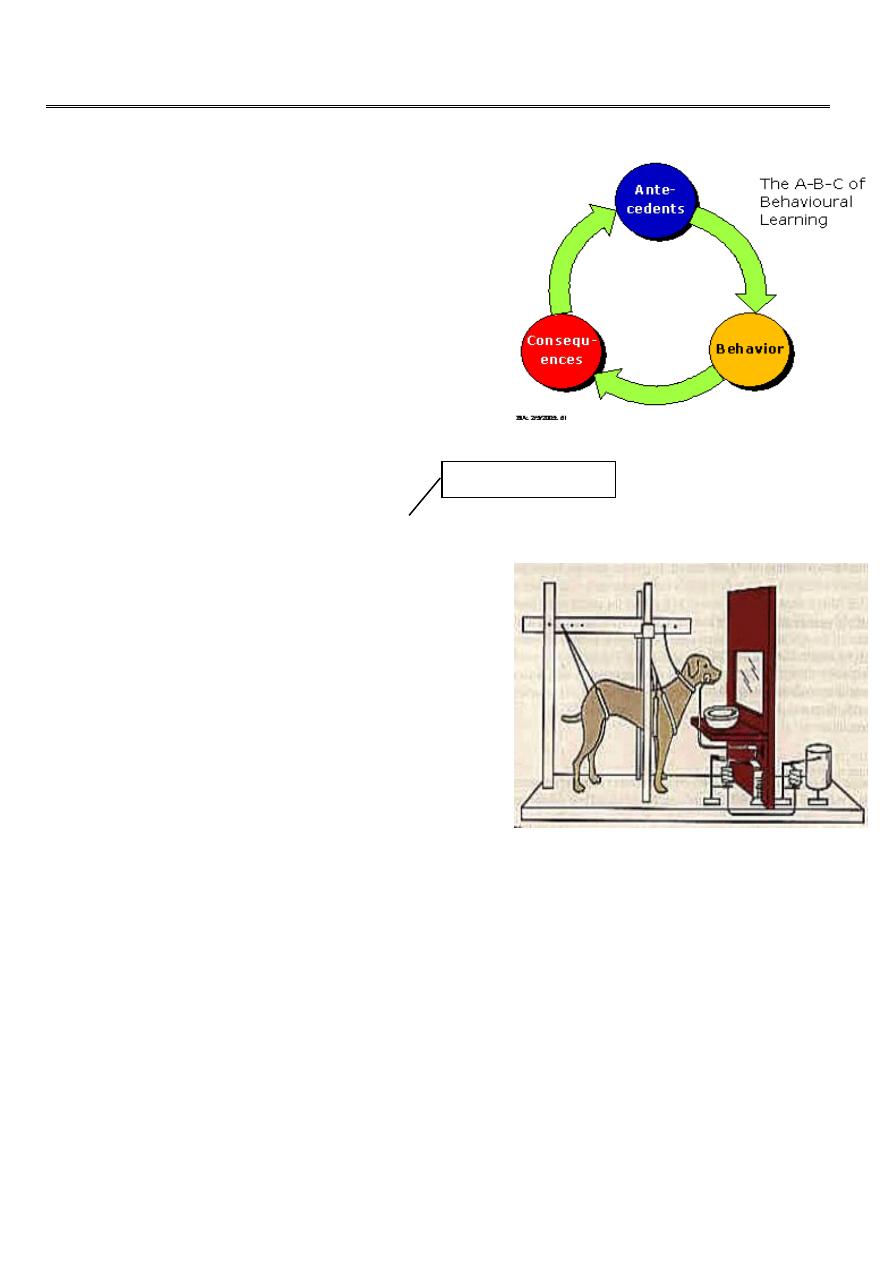
43
4th stage
Learning
Lec-9
ا.د.الهام
الجماس
6/10/2015
Relatively permanent change in behavior as a result
of prior experience
Tasks used to study the phenomenon can be
grouped to 4-categories:
1. Classical conditioning
2. Operant conditioning
3. Multiple response Learning.
4. Cognitive learning.
A. Classical conditioning: Ivan PAVLOVs Experiment (Russian psychologist)
Pavlov studied the autonomic reflexes associated
with digestion, Pavlov noticed that noticed that a
dog salivated not just when the food was placed in
its, mouth but also to the mere sight of food.
Is the formation of association between a
conditioned stimulus & response through a
repeated presentation of the conditioned stimulus
in a controlled relationship with an unconditioned
stimulus that originally elicit the response.
Associative learning can be studied in conditioned response experiments.
Flow of saliva to food placed in mouth = unlearned response (unconditioned response)
Response to sight of food = learned response (conditioned response)
Pavlov taught the dog to salivate to various signals such as light tone, there by prove the
stimulus response association
Before conditioning:
CS (light) No response
U.S (Food) UR (salivation)
Important: assay

44
During conditioning:
US (food) UR (salivation) several trials
(few seconds)
After conditioning:
CS (Light) CR (salivation)
Law of classical conditioning:
1. Acquisition:
Each paired presentation CS&US =Trial
Period of learning=stage (vary)
Exp. Indicate that learning is fastest if the CS is presented about0.5 sec. before US.
The procedure for pairing the CS &US is called REINFORCEMENT
2. Extinction:
Repetition of the CS without reinforcement called extinction
3. Generalization:
Account for our ability to react to novel situation in so far as they are similar to familiar
ones
4. Discrimination:
Whereas generalization is a Reaction to similarities, Discriminations the reaction to
differences (Child using term Daddy for all men), child learn to discriminate cats, sounds
from Dogs sounds
Important: all
Note:
Positive reinforcement acquisition
Negative reinforcement extinction
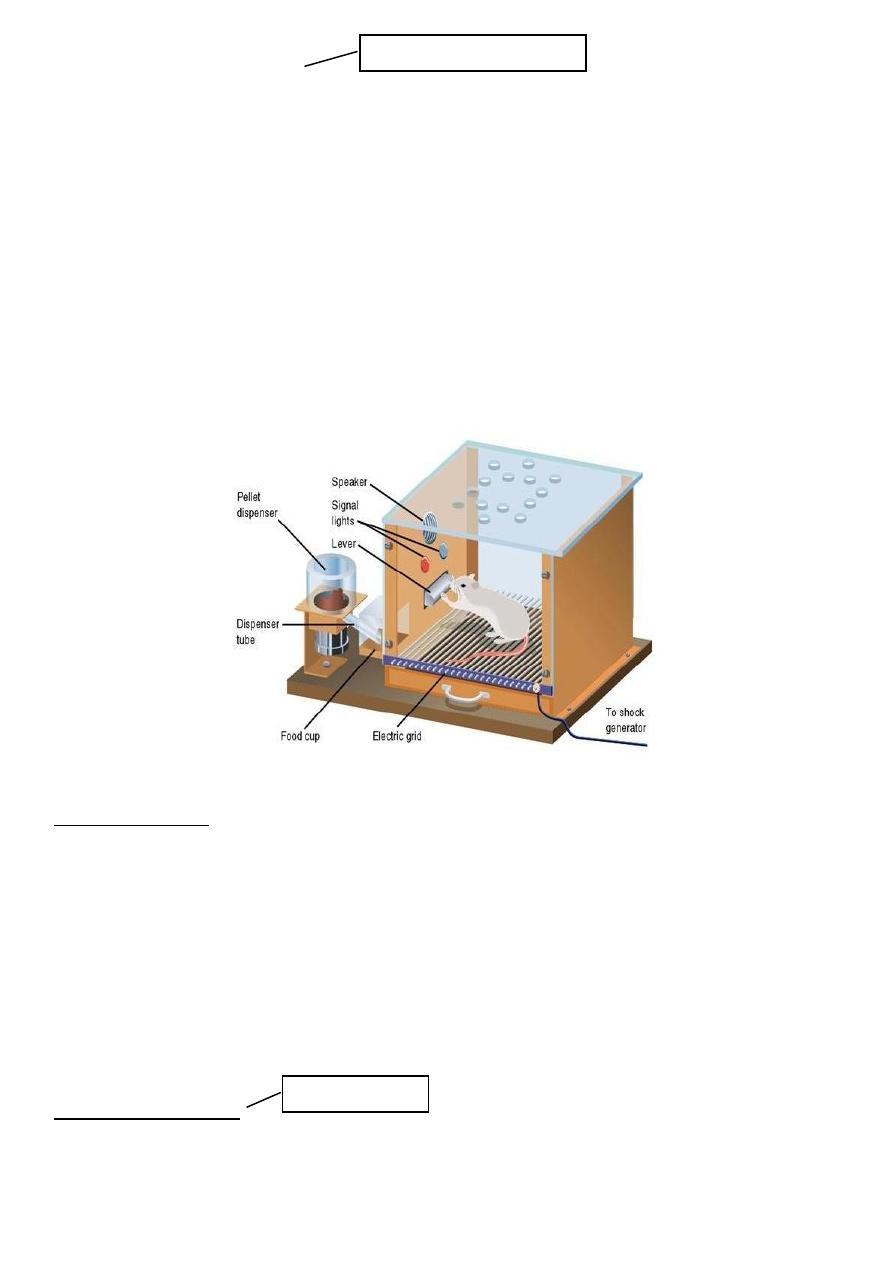
45
B. Operant conditioning:
Operant behavior = operate
(SKINNER)
The reinforced behavior bears no resemblances the behavior normally elicited by the
reinforcing stimulus e.g.
Ringing the bell = raising the bell
Light on pupil = constriction
In operant conditioning the animal is active. Skinners exp.is placing the rat in a box with a
bar, if pressed, food will be delivered, the more it press the more food will be delivered &
vise versa .Extinction happen if no food is available.
REINFORCEMENT:
Any event whose occurrence increases the probability that a stimulus will on a subsequent
occasions evoke a response.
Eg Positive (food, Negative (shock).
It is most important to reward or punish the organism immediately after it responds.
The reinforcement effect of stimulation in certain areas of the brain (primarily in the
hypothalamus) are powerful.
SHAPING of behavior:
Reinforces the only response that meet the experimenters specifications & extinguishing all
other e.g. (enuresis, shy, with drawn, stealing& all other conduct disorders
Important: all
Important: short notes

46
C. Multiple response learning:
e.g. Memorizing poem, athletic training , mirror drawing test …etc.
Learning that result from acquired pattern or sequence of behavior which involve more
than one identifiable act with the order of events usually fixed by the demand of the
situation.
D. Cognitive learning:
The learner form a cognitive structure in memory which preserve & organizes information
about the various events that occur in the learning situation
e.g insight experiment of Kohler on chimpanzee ( sultan ) ( Fruit , Sign learning
What lead to do what
Acquired expectation that one stimulus will be followed by other in a particular context. It
is classified as learning with understanding other than with conditioning e.g Chimpanzee,
(boxes, Fruit hanged from the roof).
Q: Which psychologist is famous for his pioneering work in classical conditioning?
A: B.F. Skinner
B: Sigmund Freud
C: John B. Watson
D: Ivan Pavlov
E: Robert Rescorla
Q: What is the name for the operant conditioning technique in which complicated
behaviors are taught by sequential reinforcement?
A: instructing
B: shaping
C: leading
E: modeling
D: scaffolding
Important: short notes
Important: short notes
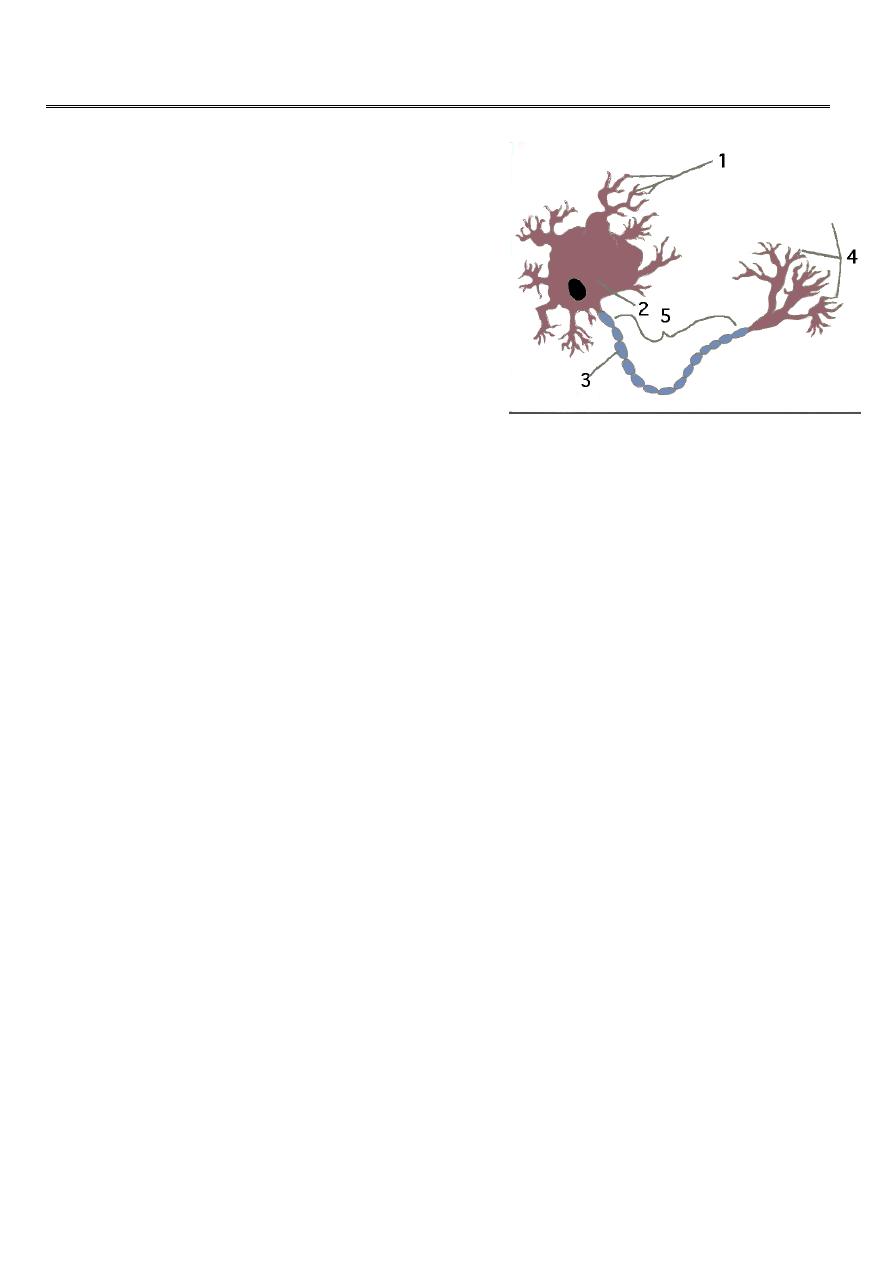
47
4th stage
Biological basis of behavior (1)
Lec-10
ا.د.الهام
الجماس
7/10/2015
Neuronal activity
Activity in the Central nervous system begins at
the cellular level, with both electrical and
chemical processes. In psychology, we first
study the activity of the central nervous system
at the cellular level.
Biology + environment --------------
behavior
Neurons receive information via the dendrite
and pass information down the axon to the
synapse .
The basic unit of the nervous system,it hold the secret of how the brain work( nature of
consciousness,transmission of impulses ,emotion & thought).
Neurons vary in size,appearance ,neurons of the spinal cord may have an axonof 3-
4ft.long,brain neurons may have few thousands of an inch.
The nervous system in addition to the neurons consist of a large no. of non neuronal
cells =glial(glue)cells which present in a ratio of 9/1(G/N)its function is to hold the
neuron inplace,providing nutrient to neuron,& cleaning of neuronal
environment.Uncontolled proliferation of glial cells is the cause of most brain tumors.
In human brain there is 10bil-1tril.N X9=no. of glial cells!
At the synaptic junction more than70 diff neurotransmitters have been identified.
Action Potential:
Excitatory impulses and inhibitory impulses alter a cells internal potential or charge. When
a cell's potential reaches a certain level, the cell "depolarizes" or becomes positive, causing
an action potential .
Electrical impulses passes along the axon in speed of 2-200miles /hr.
Ion Movement within the Action Potential :
The action potential causes a rush of sodium ions (positive) into the neuron and potassium
ions (minus) out of the neuron, The cell "repolarizes" as the ions become balanced, often
causing a "hyperpolarization ."
Key in a lock:
As a result of the action potential, neurotransmitters are released into the synaptic
junction. Specific neurotransmitters bind with specific receptor sites to allow the passage of
chemicals into the receptor neuron .
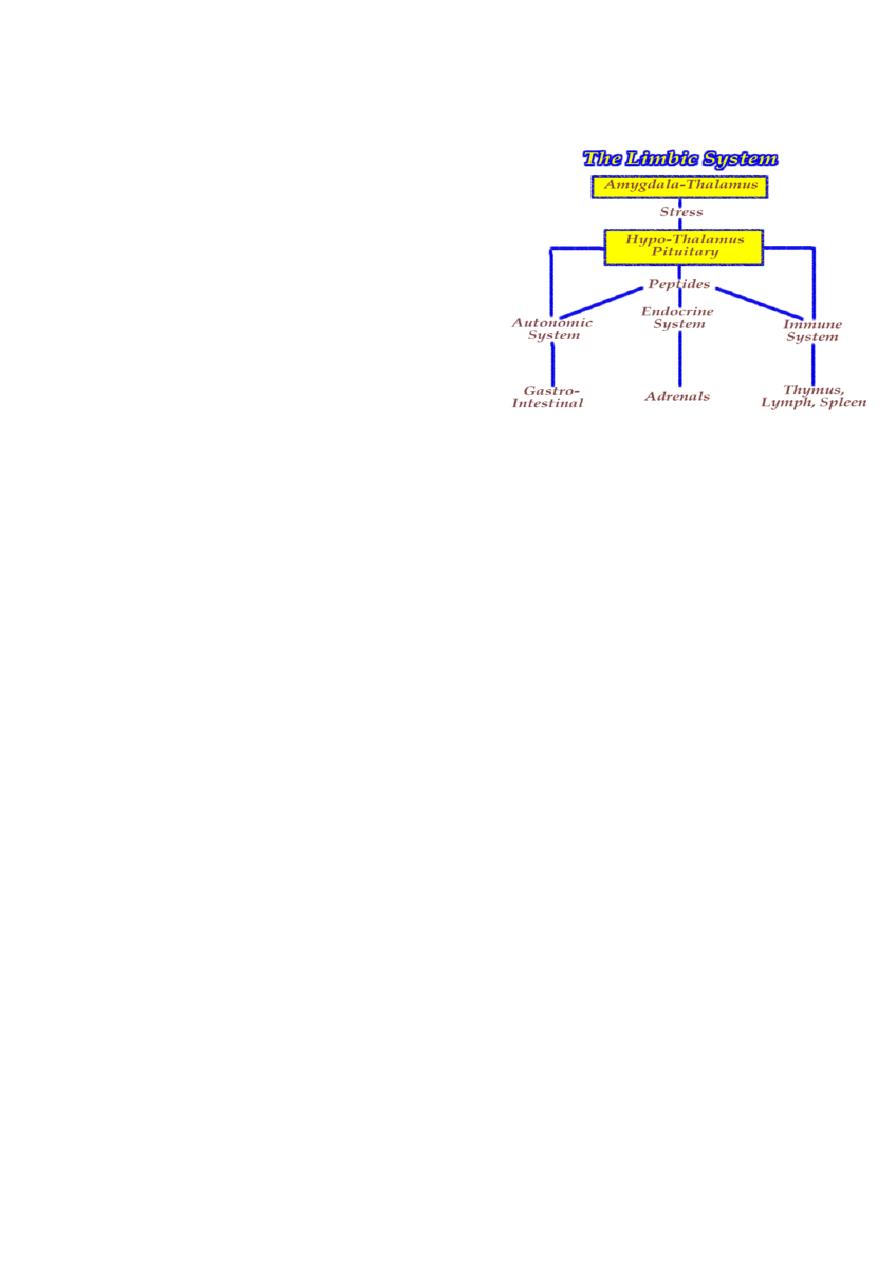
48
The action potential causes a release of neurotransmitters which bind to the receptor site
much like a key in a lock. This triggers a post-synaptic potential, which opens the post-
synaptic membrane. Excess neurotransmitters are cleared from the synapse so future
action potentials can occur
Biological basis of behavior:
Reuptake of Neurotransmitter :
The terminal button of the axon reabsorbs (takes
up) the left-over neurotransmitter in the synapse.
This reduces the chance of the post-synaptic cell
from being re-excited by the initial action
potential .
Blocking the Receptor :
Antagonists can block the receptor site, thereby preventing neurotransmitters from binding
with receptor sites. Drugs such as Curare, can cause lethal paralysis by preventing activity in
motor neurons, including those which control the muscles in the lung. You may be more
familiar with Novicaine, a centrally-acting blocker. After being injected with Novicaine at
the dentist's office, you experience a loss of feeling, as Novicaine occupies or blocks sensory
receptors Drugs Acting as Transmitters :
Agonists, can act as neurotransmitters, thereby causing the post-synaptic membrane to
"open" or "fire". A drug such as Mescaline mimics the neurotransmitters Dopamine and
Norepinephrine which are responsible for initiating and maintaing arousal and alertness .
Drugs which Block Reuptake :
Cocaine, commonly known as a stimulant, blocks the reuptake of dopamine, seratonin, and
norepinephrine, which play a role in regulation of mood. Initial use can cause elevated
mood, as excess amounts are released. When the reuptake of these transmitters is blockes,
the excess dopamine continues to excite the receptor. However, over time the body
produces less and less, and the natural stores are depleted, resulting in decreased mood .
Synapse
Synapse Overview/Summary Cells communicate through electrical and chemical
interactions . Electric communication begins with Action Potential Depolarization causes
release of neurotransmitters Chemical interactions are caused by release of
neurotransmitters Neurotransmitters cause a change in the post-synaptic cell The post-
synaptic cell can also be changed through : drugs which act as neurotransmitters (agonists )
increase release of neurotransmitter increase production of neurotransmitter mimic
presence of neurotransmitter act directly on receptor drugs which block receptors
(antagonists ) drugs which cause neurotransmitters to remain (block re-uptake

49
4th stage
Biological basis of behavior (2)
Lec-11
ا.د.الهام
الجماس
7/10/2015
Organization & Structure
The central nervous system has an inherent organization and structure. With an
understanding of cellular activity, we then study this organization .
The Central Nervous System comprises the brain and spinal cord.
The Peripheral Nervous System comprises the nerves external (peripheral) to the spinal
cord .
The Autonomic Nervous System is comprised of the Sympathetic and Parasympathetic
Nervous Systems. These systems are responsible for activating and de-activating internal
states needed at moments of "fight vs. flight ."
Division of the Lobes of the Cerebral Cortex
Frontal Lobes :
o Planning, coordinating, inhibiting actions
o Supervisory control over cortex
o Motor relay station
Temporal Lobes :
o Primary auditory reception and relay (cortical)
o Auditory and musical memory
o Sense of timing
Parietal Lobes :
o Primary somatosensory reception and relay
o Arithmetic & Language Organization (angular gyrus(
o Sense of position & direction
Occipital Lobes :
o Primary (cortical) visual reception and relay
o Visual perception
Sensory and Motor Areas :
o Cortical sensory perception
o Cortical motors control
Neuropsychology of Speech :
o Broca's Area (expressive) and Wernike's Area (receptive) are crucial to
communication.

51
Epilepsy:
Epileptic Seizures result from random electrical activity. This electrical activity spreads from
one brain area to many, creating an overload of synaptic activity .
Split-Brain Procedure:
In order to control the electrical activity caused by epileptic seizures, researchers separated
the hemispheres of the brain. By cutting the corpus collosum, which connects the two
hemispheres,
Explains the procedure and the resulting cognitive changes.
I. Neurons: The Messengers
A. Overview and general structural organization of nervous system
B. Structure of Neuron
o General
o Dendrites
o Cell body
o Axon
o Myelin sheath
o A Nerve or Tract is a group of axons
o Bundled together.
C. Kinds of Neurons:
o Sensory (afferent; inward)
o Motor (efferent; outward)
o Interneurons (between afferent and
o efferent)
o Note: also Glial cells (glia; "housekeeping)"
o but they don't transmit impulses)
D. The Neural Impulse: Transmission within a neuron Polarization and Resting Potential
.
E. The Synapse: Transmission between neurons
The Synapse
The Pre-synaptic Anatomy and Activities
a. Terminal Button or Synaptic Knob
b. Synaptic Vesicles
c. Neurotransmitters
d. Synaptic Cleft or Synaptic Space

51
The Post-Synaptic Anatomy and Activities
a. Receptor Sites
b. Reuptake
Neurotransmitters
a. Acetylcholine
b. Dopamine,
c. Serotonin ,
d. Norepinephrine,
e. Endorphine
Over 50 different kinds. Fragments of other organic molecules can simulate
neurotransmitters. Some neurotransmitters have multiple functions (excitatory,
inhibitory). Antagonists block or inhibit the normal process. Agonists facilitate it
Acetylcholine (ACh):
Usually excitatory. Attention, arousal , motivation, memory, skeletal muscle
movement. Skeletal muscles and hippocampus. In muscles, botulism toxin prevents
release of Acetylcholine (Ach). Curare and cobra venom block receptor sites. Venom of
black widow spider and certain nerve gases have a destroy Enzyme (AchE) that degrades
Ach, allowing it to flood the synapse and prolong its action, causing convulsions. Possible
link to Alzheimer's via reduced production of Ach in brain cells.
Dopamine:
General Wide range of behavior and emotions.
Excess = schizophrenia; shortage = Parkinson's disease.
Chlorpromazine, a tranquilizer, blocks receptor sites in brain .
Cocaine also inhibits reuptake of dopamine. This was the neurotransmitter focused on in
the book/movie Awakenings, especially its chemical precursor L-Dopa.
Serotonin.
Generally inhibitory. Most activities, sleep onset, mood, eating. LSD has similar structure
and activates neurons in the brain that are normally inhibited by that neurotransmitter .

52
Medications for depression and anxiety such as Prozac, Paxil, Zoloft, and Luvox are all
Selective Serotonin Reuptake Inhibitors (SSRI.)
Norepinephrine (NE).
Generally excitatory. Arousal, wakefulness, learning, memory, mood. Neurons in brain
stem .
Amphetamines, cocaine slow down reuptake and prolong action, lithium speeds up the
reuptake
Gamma-aminobutyric acid (GABA): Inhibitory.
Glutamate. Involved in long term potentiation.
Endorphins: (name composed of endogenous morphine: natural
opiate-like neurotransmitter--or often referred to as
neuromodulator—which is linked to pain control and pleasure
II. Central Nervous System
A. Brain
Hindbrain (central core)
a. medulla - controls breathing, heart rate, and blood pressure.
b. pons -- connects the cerebral cortex at the top of the brain to the cerebellum .
c. cerebellum -- controls certain reflexes, coordinates body movement ,and maintains
equilibrium.
Midbrain (limbic system):
The region between hindbrain and forebrain which is important for hearing and sight and is
one of the primary places in the brain where pain is registered. Hippocampus and
amygdala.

53
Forebrain
a. Thalamus
b. Hypothalamus
c. Cerebrum/Cerebral hemispheres
d. Cerebral Cortex
B. Cortical areas and their functions .
Occipital: visual information
Temporal: auditory information
Parietal: somato-sensory
Frontal: voluntary motor movement
C. Hemispheric specialization
Corpus callosum
Left Hemisphere
Right Hemisphere
Split-brain"" Psychosurgery
D. Reticular formation: wakefulness,
alertness, arousal. Spread across
hindbrain, midbrain, and into forebrain.
E. Limbic system
Memory and emotions
Primary structures:
a. Hippocampus
b. Amygdala

54
Cerebral lateralization
Left hemisphere right hemisphere
Memory for words & numbers Memory for shapes &music
Word recognition
Facial recognition
Positive emotion negative emotion
Response to complex commands Response to simple commands
F. Spinal cord
Structure
Spinal reflexes
G. Tools for studying nervous system
Microelectrode techniques: inside the neuron itself
Macroelectrode techniques: EEG Alpha, Beta, Delta and Theta Waves
Structural imaging (CAT scan) Functional imaging (fMRI
III. Peripheral Nervous System
A. Somatic nervous system
Skeletal (striped) muscles
B. Autonomic nervous system
1.
Smooth muscles.
2.
Sympathetic branch:
a. Prepares for emergency or arousal.
b. Fight or Flight
3. Parasympathetic branch:
a. calms, relaxes body, returns to
normal; involved in digestion and
processes which conserve and protect
bodily functions.
b. controlled in relaxation work, especially bio-feedback
Important: all

55
A. Function
1.
Release hormones from ductless glands into bloodstream
2.
Organize nervous system and body tissues
3.
Activate behavior
B. Thyroid
1.
Regulates metabolism
2.
Affects activity level and emotional state.
C. Parathyroids
D. Pineal gland: Day-night activity levels
E. Pancreas
1.
Insulin/glucagon
2.
Blood sugar regulation
F. Pituitary
1. Posterior
a. Vasopressin
b. Oxytocin
2. Anterior: "master gland;"
a. Linked also to nervous system and
i. hormones released by hypothalamus
b. Produces growth hormone
c. Releases ACTH (stress hormone) and
i. can effect the adrenal glands
G. Gonads
1.
Males: androgens (testosterone )
2.
Females: estrogens (progesterone)
a.
3
. Sexual/reproductive function. Studies suggest that they have some other effects,
e.g., effects on aggression and on learning
H. Adrenal Gland
V. Behavior Genetics and Our Human Heritage
A. Genetics
1.
Basic Facts.
2.
Chromosomes and Genes
a. Genes
b. Chromosomes

56
c. DNA
d. Dominant and recessive genes
e. Sex-linked genes (M > F)
(1)
color blindness
(2)
hemophilia
f. Blueprints or recipes?
B. Genetics and Behavior
1. Animal Behavior Genetics:
a. Heritability of behavioral traits
b. Selective brding: Thompson
2. Human Behavior Genetics:
a. Human Genome Project: Map all 23
i. sets of human chromosomes.
b. Family Studies
c. Twin studies: identical vs fraternal.
i. Schizophrenia: Identical twins 50%;
ii. fraternal 15%
d. Adoption studies
C. Evolution:
1.
Natural selection: How evolution occurs
a. and which traits survive.
3.
Can restate Darwin using gene theory.
D. Evolutionary Psychology
1.
Environmental influences on gene action
2.
2
. Evolution with its natural selection, predisposes humans in certain ways, thus
is the direct cause of certain behavioral traits, e.g., aggressiveness and sexuality
in men, submission and nurturance in women.
E. Social Implications
F. Environment-Genetic Interaction :
1
. Genes predispose to environmental influence, environment supplies
influence to actually produce behavioral
effect
2
. Examples : Diabetes <=> overweight Schizophrenia <=> stress
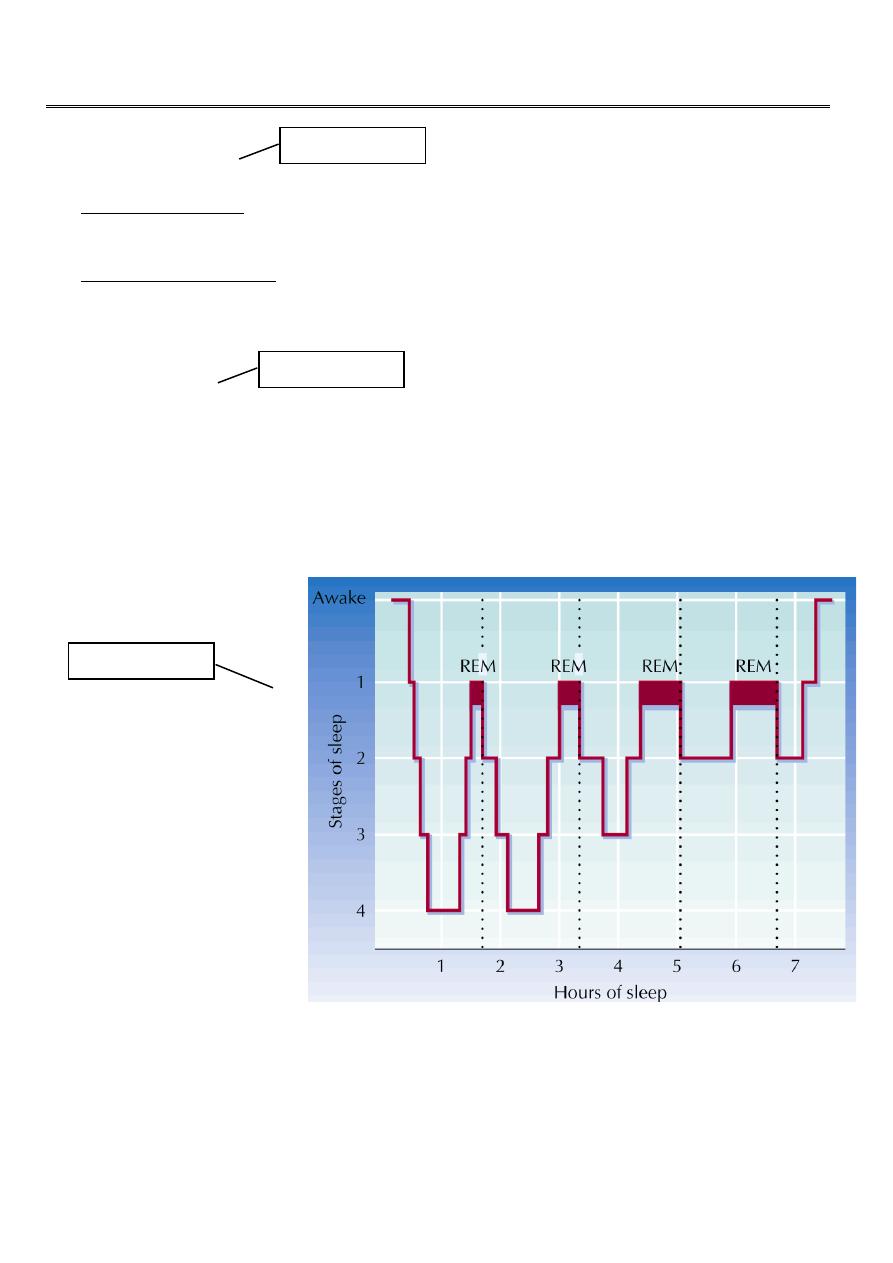
57
4th stage
Sleep and dream
Lec-12
ا.د.الهام
الجماس
7/10/2015
Theories of Sleep:
Repair/Restoration:
o Sleep allows for recuperation from physical, emotional, and intellectual fatigue
Evolutionary/Circadian
o Sleep is part of a circadian cycle
o Sleep evolved to conserve energy and protect from predators
Myths of Sleep:
Everyone needs 8 hrs of sleep per night to maintain health
Learning of complicated subjects can be done during sleep
Some people never dream
Dreams last only a few seconds
Genital arousal during sleep reflects dream content
STAGES OF SLEEP:
Sleep stages:
non-rapid eye movement (NREM or non-REM)sleep
rapid eye movement (REM)sleep
Important: all
Important: all
Important: all
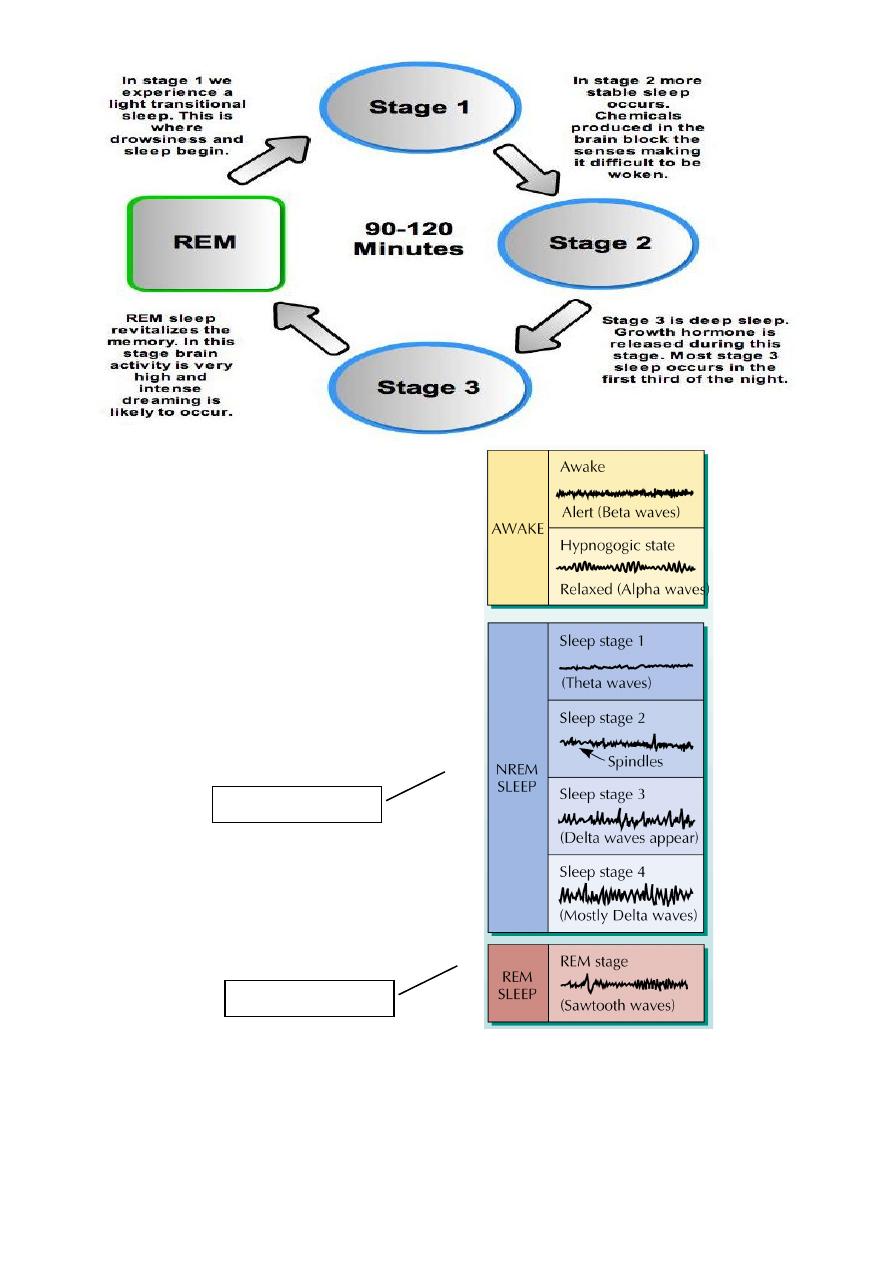
58
EEG Changes during Sleep:
Sleep:
Sleep proceeds in cycles of REM and NREM, the order normally being N1 → N2 → N3 → N2
→ REM. There is a greater amount of deep sleep (stage N3) earlier in the sleep cycle, while
the proportion of REM sleep increases later in the sleep cycle and just before natural
awakening.
Important: MCQ
Important: MCQ
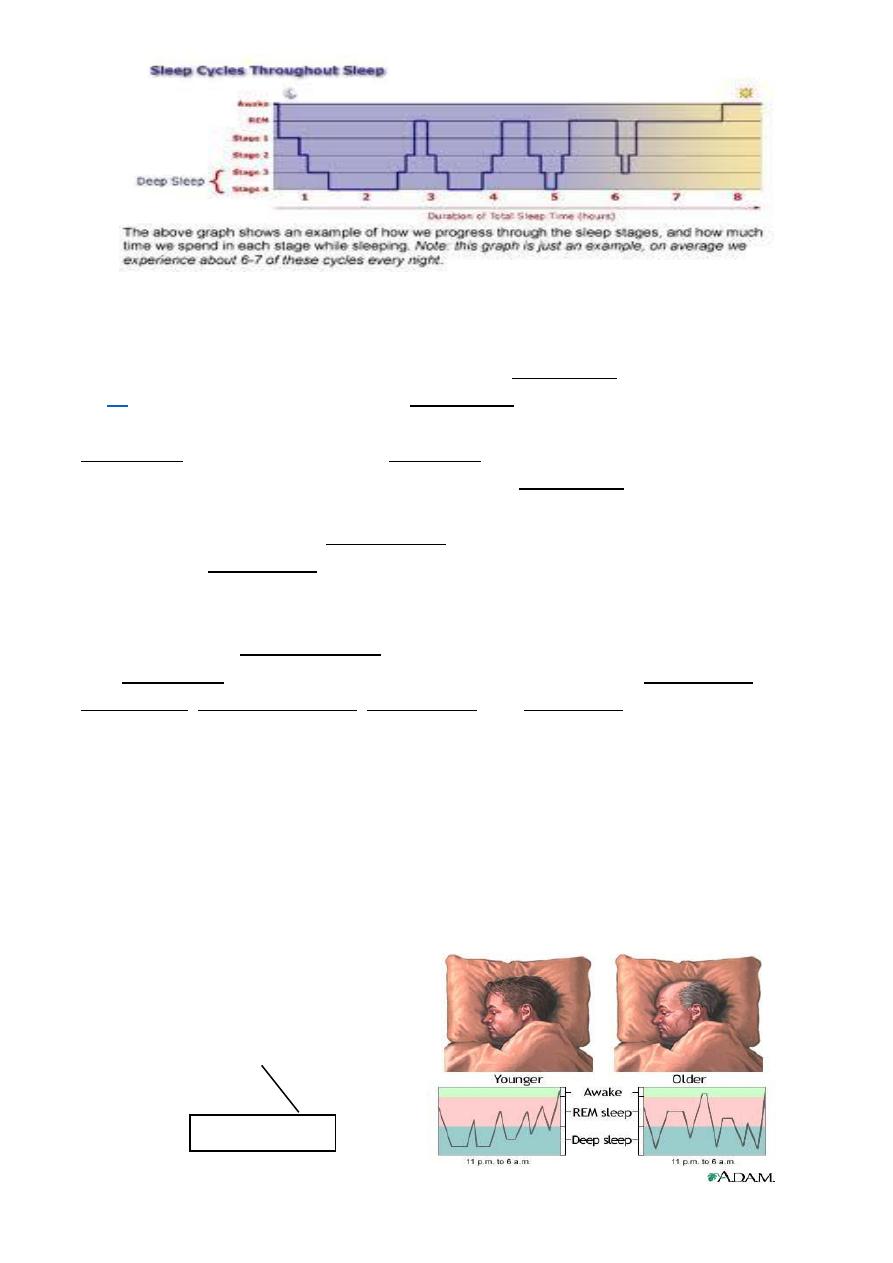
59
(NREM or non-REM) sleep:
o Stage N1 refers to the transition of the brain from alpha waves having a frequency of 8–
(common in the awake state) to theta waves having a frequency of 4–7 Hz. This
stage is sometimes referred to as somnolence or drowsy sleep. Sudden twitches and
hypnic jerks, also known as positive myoclonus, may be associated with the onset of
sleep during N1. During N1, the subject loses some muscle tone and most conscious
awareness of the external environment.
o Stage N2 is characterized by sleep spindles ranging from 11 to 16 Hz (most commonly
12–14 Hz) and K-complexes. During this stage, muscular activity as measured by EMG
decreases, and conscious awareness of the external environment disappears. This stage
occupies 45–55% of total sleep in adults.
o Stage N3 (deep or slow-wave sleep) is characterized by the presence of a minimum of
20% delta waves ranging from 0.5–2 Hz. This is the stage in which parasomnias such as
night terrors, nocturnal enuresis, sleepwalking, and somniloquy occur.
o Many illustrations and descriptions still show a stage N3 with 20–50% delta waves and a
stage N4 with greater than 50% delta waves; these have been combined as stage N3.
(REM) sleep:
o The criteria for REM sleep include rapid eye movements as well as a rapid low-voltage
EEG. Most memorable dreaming occurs in this stage. At least in mammals, a descending
muscular atonia is seen. Such paralysis may be necessary to protect organisms from self-
damage through physically acting out scenes from the often-vivid dreams that occur
during this stage. It start 90 min after sleep also called paradoxical sleep
(REM) sleep:
o Infant spend half their sleep in rem
o 20-25% by age of five
o 18% in adult
o Elderly 3-4%
Important: all
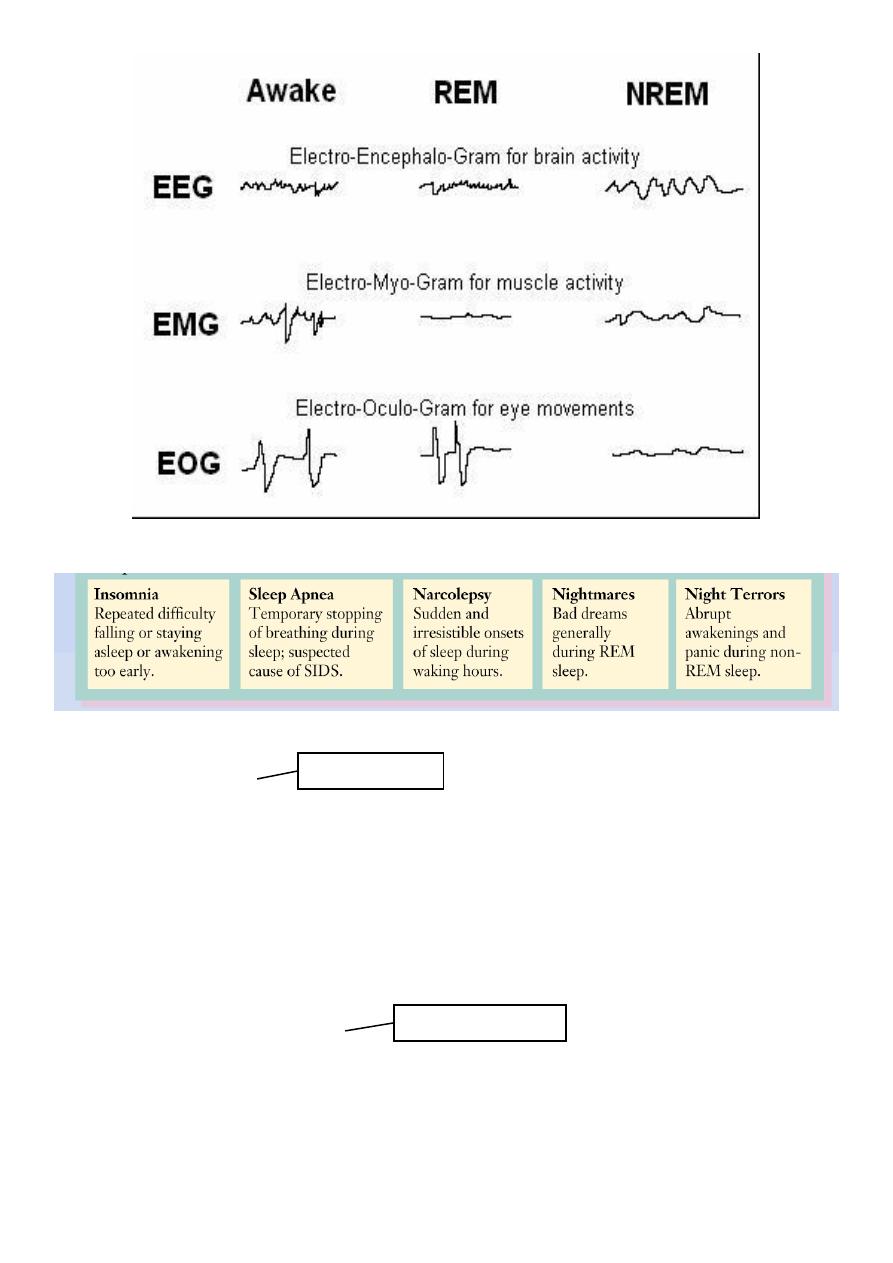
61
Sleep Disorders:
Functions of Sleep:
REM Sleep:
o Consolidation of new memories
o Role in learning
o Absent in lower mammals
Non-REM sleep
o People deprived of all sleep show greater time spent in non-REM sleep the next
night
Effects of Sleep Deprivation:
Reduced immunity
Mood alteration
Reduced concentration and motivation
Increased irritability
Lapses in attention
Important: all
Important: assay

61
Reduced motor skills
Sleep regulation:
Most researchers think that sleep is regulated by small numbers of interconnecting
systems or center that locate chiefly in the brain stem and that mutually activate and
inhibit one another
Many studies support the role of serotonin in sleep regulation, lack of serotonin found
to reduce sleep for considerable time
also Adenosine which is created over the course of the day, high levels of adenosine
lead to sleepiness
Function of sleep:
Restoration of homeostatic function
Appear to be crucial for normal thermal regulation and energy conservation
Rem stage may associated with satisfying metabolic needs
Sleep deprivation & sleep debt:
Prolong period of sleep deprivation lead to ego disorganization
Rem deprivation lead to irritability and lethargy
Sleep debt is the effect of not getting enough rest and sleep; a large debt causes
mental, emotional and physical fatigue.
Sleep debt results in diminished abilities to perform high-level cognitive functions.
Sleep requirement:
Some persons normally sleep fewer than 6 hours to function adequately called short
sleeper
Those who sleep more than9 hours each night called long sleeper
Long sleeper have more rem sleep
Sleep need increased with physical work, exercise, illness, pregnancy, general mental
stress and increased mental activity

62
Dreams
Dreams:
State of consciousness in which remembered image and fantasies which are
temporarily confused with external reality
Dreaming is the perceived experience of sensory images and sounds during sleep, in a
sequence which the dreamer usually perceives more as an apparent participant than as
an observer
Theories of Dreaming:
Psychoanalytic: Dreams represent disguised symbols of repressed desires and
anxieties
Biological: Dreams represent random activation of brain cells during sleep
Cognitive: Dreams help to sift and sort the events of the day
Freud’s theory: His psycholytic theory states that dreams are unconscious wish
fulfillment of need unmet during waking states. He believe that dreams often involve
combination of early childhood experience and daily residue
Cognitive theory: proposes that dreaming can best be understood by relying on the
same cognitive concept that are used in studying the waking mind, it mean that dreams
involve in processing information, memorization and possibly problem solving.
Activation-synthesis theory : this theory state that dreams are powered by
spontaneous firing of neurons, dreams reflect the brains effort to make sense out or
find meaning in the neuronal activity take place during sleep
Dreaming:
Do you know when you are dreaming?
Yes some times during occasional awaking
Can people control the content of their dreams?
Yes by pre dream suggestion post hypnotic suggestion
Do males and females dream about different things?
Males dreams have more content about males , aggression , gross anatomy , sexuality
and dreamer involve success
Females dreams are more likely to be about females, friends and victimization
Why can't we remember all of our dreams?
We can't because dreaming occur at such a low level of consciousness , we remember
it best we awake while dreaming or just after
Important: First 3 points only
